SOCIAL ORGANIZATION
The basic dimensions of present Kipsigis social organization have been described in detail by Manners (1967) and will be discussed here only in brief. This is followed by a detailed examination of the nature of the family unit and a discussion of homestead and community organization drawn from my census and genealogical data from the community of Kapsuswek. This material supplements previous accounts of Kipsigis social organization1 and deals with that aspect of the society, the social environment of the child, which is most relevant to the psychological variables of concern in this study.
The formal aspects of Kipsigis social organization can be ordered along the dimensions of descent, age, and locality.
The Kipsigis express common patrilineal descent, beyond specific genealogical ties through known individuals, in terms of common membership in a clan2 or oret (plural, ortinwek; the word also means path or road). Various clans are said to be of autochthonous Kipsigis origin, or to be common to several Kalenjin groups, to be of specific Nandi origin, or to be identical to ortinwek known by other names among the Nandi, to be derived from the Okiek (Kalenjin-speaking "Dorobo" hunter-gatherers of the high forest zone), or from Gusii or Maasai people incorporated into Kipsigis society during the precolonial period.
A common form of a clan name is of the type Kapkomosik (kap-, the house of; Komosi, a personal name; -ik, the plural ending used with nouns referring to people). But many, perhaps most ortinwek names do not point to a presumptive ancestor (e.g. Kapsoenik, the house of buffalos). Even among those clans whose names incorporate a personal element, there is little attention paid to an individual ancestor as an historical or mythical personage, and no attempt is made to trace a line of descent from the clan's originator to its present members.
The description of ortinwek as "clans" in English has presented several difficulties, arising in part from the fact that the term oret is used to denote different degrees of inclusiveness. Many clans are recognized to be divided into a few "houses" (korik) though these sub-division names are rarely heard. In other cases, however, sub-division names are the ones most frequently used; for example many people identify their oret as Kapsoigoek although it is general knowledge among men 3 that those people, along with member of Kapchebulungu and Narachek are all members of one oret, also called Narachek, which is the exogamous unit.
Peristiany (1939:118) speaks of clan, section, and subdivision, only the last of which, if the clan is in fact subdivided, is exogamous. He applies the term kot-ap-chi (discussed more fully below) to the exogamous unit, reserving the term oret for wider, non-exogamous groupings identified by association with a totemic "animal" (tiondo). Manners, however, takes the recognition of exogamy as the criterion for his use of oret. The primary sources for the Nandi show a parallel disagreement in the use of terms: Hollis (1909:4-6) translates oret as both clan and family, the letter being a subdivision of the former. In Hollis' terminology the family, but not the clan, is the exogamous unit. Huntingford (1953:20) interprets the term oret specifically as the exogamous unit, which he calls the clan. In fact, although the Kipsigis recognize that some ortinwek are the outgrowths of antecedent categories (fission is perhaps the wrong word here since the separation arises out of the attenuation of common interests among a large number of widely dispersed homesteads, rather than a split along any genealogical lines), these subdivisions are seen to vary case by case, and there is no clear hierarchy of levels in an abstract sense such as has been described for segmentary lineage systems.
Not only are the upper limits of some ortinwek vague, but the critical feature, the range at which exogamy should be observed, is subject to ambiguity and differences of opinion. Thus there are clans which were said to have been "of one house" or "siblings" in the past but which now intermarry. Orchardson comments (1961:15):
There are also cases in which only a few older men, perhaps because of their numerous affinal ties, realize that two named categories are subdivisions of what has been considered an exogamous unit. One informant, over seventy years old and unusually interested in such matters, reported that it was not altogether rare for a marriage, particularly by elopement, to occur between members of two ortinwek which the old men still considered too closely associated to intermarry. As Orchardson (1961:15, writing before 1929), Peristiany (1939:123), and Manners (1967:245) have all noted, the subject of clan affiliation is quite secondary in most matters, is little discussed, and not closely followed beyond the range of one's significant affines. Within that range, however, an individual is related to members of a large number or clans, and a key feature of Kipsigis society is the classificatory expansion of kin terms via clan affiliation to connect to new acquaintances or new neighbors: 'Oh, you belong to Kibaek. My brother married a Kibaek woman. Hello, brother-in-law! ('Ochamege, kapyugoi!').
Clan affiliation is one of the central subjects of a marriage negotiation (koito) in which all parties must be satisfied that not only is there no question of violating clan exogamy, but that there is no unresolved homicide, or any pattern of infertility or unusual infant mortality involving marriages, between the two ortinwek. Further, it must be determined that the two people to be married are not cognatically related within the last few generations, and for these purposes potentially common ancestors are identified by the combination of name, locality, age-set, and clan affiliation. Since clans are not localized groups. and most Kipsigis marriages tend to be between families who live within a few miles of each other and know each other quite well, marriage negotiations usually do not require extensive discussion of clan affiliations. Still such matters must be checked; I know one case of a young man who traveled quite far from his home community to pay court to a young woman he had met in Kericho town only to discover during the opening pleasantries of his visit that her father was a kinsman.
When asked "To which clan do you belong?" (I bo an ora?), the majority of men will respond with the name of the descent category which they recognize as the largest exogamous groups.4 In this sense Huntingford's and Manners' use of the term oret is perhaps the best reflection of the everyday use of the term by the Kipsigis if it is remembered that this usage contains a good measure of ambiguity.
In the case of clans, as in the case of virtually every Kipsigis social category or group, membership is determined ultimately by local concensus. If one moves, such matters can always be adjusted if they prove inconsistent with the local concensus in another area. Questions of clan membership, age-set membership, community membership, and the like are resolved on a local, ad hoc basis. Membership in any group, i.e. one's social identity, ultimately is dependent upon present or past behavior (especially during initiation).
There remain some ambiguous aspects of descent among the Kipsigis that will probably never be fully understood because of historic changes. One is the question of the "totemic" nature of clans (Peristiany 1939,117: Manners 1967, 245). The situation may be described briefly as follows: many men, particularly older men, report that their "clan" (which may or may not be an exogamous unit) "has an animal" or two or more animals. An animal (tiondo, the term excludes domesticated species) in this sense may be a cockroach or a bird as well as a lion or a gazelle. It is possible for two intermarrying clans to recognize the same animal or for two men in the same clan to recognize different animals. These considerations apparently have little or no significance today. Even the oldest men could not explain what the system of clan animals was all about, and showed no interest in such questions. The majority of younger men are vague about their own tiondo affiliation.
In addition to membership in a clan (oret) and totemic identifications of some sort, each Kipsigis man in the pre-colonial period recognized his membership is one of four boriosiek (singular, boriet).5 Membership in a particular boriet was inherited from one's father, though a man could arrange a ceremony placing a son in a different boriet from his own (just as he could also assign his sons different patronyms). Thus all members of one clan were not members of the same boriet (cf, Orchardson 1961:11; Peristiany 1939:162. Manners (1967:247) discusses the lack of a simple correlation between oret and boriet in some detail. In the past Kipsigis warriors organized offensive units into four lines (kwanaik, singular = kwanet), each composed of the members of one boriet. For this reason most authors translate boriet as "regiment" (Manners suggests "phratry").
It appears that during the original Kipsigis expansion into Kericho District the boriosiek were associated with specific geographic areas, as they were among the Nandi up to the twentieth century (Huntingford 1953:8).6 As the process of expansion and migration continued among the Kipsigis, members of each boriet were to be found in every local area (Peristiany 192=39:162).7
The main function of the boriosiek, to mobilize warriors in distinct fighting units, was dropped after a disastrous battle with the Gusii in which the enemy concentrated on one kwanet and annihilated it.8 After that it was decided to mix the members of the boriosiek in each line of battle. Since then the boriosiek system has not served any real function. Today most younger men do not know their boriet affiliation.9
| AGE-SET | Sub-Set | Dates of Initiations |
|---|---|---|
| KORONGORO | Kipkoimet | 1838a - |
| Kiptormesendet | ||
| Kibelgot | - 1859a | |
| Kimarare | - 1858b | |
| KAPLELACH | Kiboloeng' | |
| Kimutaiywet | ||
| Kimasiba | ||
| Kebebuja | 1891 | |
| KIPNYIGE | Kipsilchoget | 1896c - |
| Tabarit | ||
| Kiptilosiek (Cheptechoret) | ||
| Kiptilgarit | 1901 | |
| NYONGI | Kosigo | 190? - 1910 |
| Kirsirgot | 1911 - 1915 | |
| Blu | 1916 - 1919 | |
| Mesiewa | 1921 - 1922 ? | |
| MAINA | Siling ("Shilling") | 1922 - 1923 |
| Chemorta | 1924 - | |
| Silobai | 1928 - 1929 | |
| CHUMO | Kimingiet | 1930 - |
| ------- | ||
| ------- | ||
| ------- | 1945 | |
| SAWE | ------- | 1946 - |
| Lesebet | 1952 - | |
| ------- | ||
| Kibago | 1964 - 1965 ? | |
| KORONGORO | ------- | 1966 ? |
a These dates are from Orchardson (1961:125)
b Orchardson's dating, based on the sighting of a comet.
c Orchardson gives the opening of Kipsilchoget as 1880. This was the first initiation group after the battle of Mogori, or Saosao, which Ochieng' dates to 1981 (1974:130). My estimate is based on data from one of the last survivors of Kipsilchoget.
The age-sets are arranged in a cyclical fashion so that the next age-set to follow Korongoro will be Kablelach. It takes over a century for the age-set system to go full cycle. Recruitment into an age-set is by initiation at adolescence. All initiates of 1955, for example, automatically became members of Sawe and will remain so throughout their lives. Membership is not determined by chronological age per se, and it is quite probable that some of the first members of Sawe were born before some of the most junior members of Chumo.
The Cycle of Age-Sets Among The Kipsigis

Prior to the twentieth century a period of several years separated the closing of one age-set and the opening of initiations to form the next. The transition between age-sets was marked by a ceremony, saget ap eito, the slaughtering of an ox, in which the age-set that had been undergoing initiations was declared complete and assumed the status of senior warriors, the age-set ahead of them removed their markers of warrior status and donned the emblems of elderhood, and the way was cleared for beginning initiations of a new age-set of junior warriors. In 1923 the neighboring, closely related Nandi plotted to turn the mass gathering of warriors at the next saget ap eito into a rebellion, but the colonial authorities were tipped off. The leading figure was arrested and sent into exile and the uprising collapsed (Huntingford 1953:43). Thus the last saget ap eito ceremonies among the Nandi, and I believe among the Kipsigis, were very early in the twentieth century. Since the mid-century, if not before, initiations have been held annually. Among the Kipsigis age-sets were normally divided into three major and one minor sub-sets. Unlike the same units among the Nandi, where they are known as mostinwek, fires, and given the same four names in each age-set (Huntingford 1953:59), Kipsigis sub-sets are given unique nicknames referring to historical events that marked the time of their seclusions.10
Huntingford, Orchardson, and Peristiany reviewed the data on oral traditions with the hope of establishing the periodicity of transitions and thus a chronology of precolonial history, hoping to correlate the history of local events, whose sequence was remembered in terms of age-set activities, to western calendar years. Unfortunately they focused on the precolonial situation, about which they had incomplete and contradictory data, and failed to see the significance of the fact that age-set transitions have continued to occur despite the loss of the saget ap eito and a closed period. The issues between them, therefore, remained unresolved. I discuss the intricacies of this debate and present a reanalysis of age-set dynamics based on my own fieldwork in two separate papers, Kipsigis Age-Sets: Coordination without Centralization, and The Extent of Age-Set Coordination Among the Kalenjin. It is sufficient to note here that an understanding of the system depends upon the realization that all age-set transitions are made by concensus arrived at by word of mouth without centralization of information or decision making in any appointed leadership, that transitions are not tied to any fixed number of years but are provoked by social pressures leading to local decisions which must then be coordinated, that such changes take time, and that ultimately the cohesion of the system depends upon the existence of ambiguity and retroactive adjustments at some times, in some places, and for some individuals.
One of the most important rules associated with age-set membership is that a man may not marry the daughter of a man belonging to the same age-set. Orchardson states that the saget ap eito "was not for the purpose of handling over the rule of the country from one set of warriors to another, but rather for determining publicly exogamy of generation" (1961:14). The punctuation of age-sets by saget ap eito ceremonies in various areas was necessarily approximate, and at any given celebration both recent initiates and those about to be initiated could take part (Orchardson 1961:13). The minor sub-sets, which were the ones being formed during these transitional times, provided the necessary leeway, for although they were considered the end of the age-set approaching completion, their members could, at a later date, declare themselves to be among the first members of the new, junior age-set.11 Thus one man I know initiated in the marginal Chumo/Sawe sub-set defined himself as Sawe in order to marry the daughter of a senior member of Chumo. These are of course individual decisions, locally accepted. There is no way they could be standardized; indeed such flexibility in specific instances is necessary to maintain the overall standardization of the age-set system.
Today, with the elimination of the old military organization and the saget ap eito ceremony, there is no organized age-grade of warriors nor any tribal-wide formal symbolization of when a man becomes a junior or senior elder. Although the term murenik (young man) and boiyot (decision maker or elder) are still used, their application depends upon the specific conditions of a man's life. With the dissolution of the traditional formal statuses of the age-grades, the age-sets have ceased to function as any sort of corporate units but remain social categories which serve to define patterns of interaction.
There are many explanations of the functions of East African age-sets which have been advanced. Most obvious is the observation that the age-set system mobilized the man-power of the tribe very effectively for intertribal warfare, while at the same time serving as a formal justification for the gerontocratic aspects of domestic politics.
Several authors have also noted that the behavioral norms associated with the age-sets "cut across" norms related to kinship or locality, and that is some cases a young man is more responsive to his age-mates than to his father. Peristiany also speaks of the ibinda as a "regulator of social behaviour" (1939:39) and discusses briefly the patterns of respect between generations defined in terms of age-sets (members of a senior age-set, for example, are often addressed as "father," bomong'o). The primacy of age-set roles over kinship roles in daily social intercourse with people outside the immediate family is related to the rather high incidence of polygyny among the Kipsigis. Since it is not at all rare for co-wives to be many years apart in age, it very frequently happens that people who are of the same generation, genealogically, are often of completely different generations chronologically. If one attempts to chart the genealogy of more than a few people with a vertical scale representing actual age in years, the task soon becomes impossibly complex, and quickly reveals the ridiculous situation which would result if people addressed their less immediate kin (cognates and affines), and followed the patterns of etiquette associated with such terms, according to strict genealogical relationships. The use of kin terms according to age-set membership is thus the common sense solution.
The settlement pattern among the Kipsigis has been, since the precolonial period, one of dispersed homesteads. Houses were built on higher ground (and still are within the range of available land). Thus dwellings tended to be scattered on hilltops and along ridges, with most of the gardening and grazing of domestic animals on the slopes. Population growth and land enclosure have resulted in the establishment of homesteads on all levels of a hillside throughout most of the district. The shape of the typical farm is roughly trapezoidal, narrower in width than in length down the slope. Farms, and fields within farms, are hedged with thorn bushes, sisal, or cactus (depending on the moisture of the soil). Even today the pattern of dispersed homesteads runs right up to the edges of the towns and trading centers scattered throughout the district (all such towns are intrusive).12
The basic local group among the Kipsigis is called kokwet (plural = kokwotinwek). This may be described briefly as the group of neighbors who interact on a daily basis, who recognize obligations of mutual aid and cooperation, and common responsibilities in settling disputes. A kokwet might also be defined as the social range within which women form cooperative groups to do the more onerous chores of gardening, men join together to plow, raise houses, drink, gossip, and share lunch, and children find their regular playmates. Although the host at every beer party has the right to invite or exclude whomever he wishes, one can usually assume a standing invitation at the other homesteads within one's kokwet.
The men of the community meet in public council (also called a kokwet) to settle disagreements within the group. A meeting of the kokwet may also take up matters between members of the same family if they affect the general community or if one of the persons involved has requested them to do so (one's neighbors may on the other hand decide that the issue is so much dirty family linen and refuse to hear it discussed in public). Decisions are by consensus, with the younger men leaving most of the talking to their elders. The decisions of a kokwet are enforced, to the extent that they are enforced at all, through informal social pressure.13 There are no formal offices within the kokwet; the term boisiek ap kokwet means simply the elders of the community, those men who are most influential among their neighbors. One must be an elder to command influence but it does not follow that all old men are influential.14
Because of the settlement pattern, the area occupied by a kokwet can generally be described as a hill or elevation bound by creeks or low land. This, however, should not be taken as a formal definition. Such factors as local population density as well as topographical features influence the size of the kokwet. The mean number of homesteads in a kokwet is probably not over forty. The term kokwet is also used in general conversation to refer to the land occupied by the community, though the term koret refers more specifically to land area rather than people. Koret, however, can also mean the wide area of a group of neighboring kokwotinwek.
The names of particular kokwotinwek are best understood as references to location that do not imply clearly delineated areas that can be readily mapped. Unlike the official government "village" designations, several of which comprise a sub-chief's jurisdiction (a "sub-location"), the place names in common use in Itembe, as elsewhere, refer to sites such as "by the yellow acacia trees" or to particular hills. They are not all on the same level of specificity, and need not be referring to mutually exclusive areas.
Inasmuch as a kokwet is defined in terms of patterns of interaction, it is quite possible for a man on the edge of a kokwet to be considered a member of it, even though his neighbor whose farm is between his and the rest of the community prefers to consider himself a member of the next kokwet. Similarly, there are no membership rolls for the public councils nor any idea of where to draw the line geographically between members and non-members. People who are affected by the issues at hand have the right to speak. It also follows that men of different generations, having different circles of friends, will have slightly different conceptions of the boundaries of the community.
While the above sketch is in complete agreement with earlier accounts, previous authors have not investigated in detail the role of kinship in defining and uniting the people of a kokwet. From a closer look at the data from one kokwet, Kapsuswek, it can be seen that in daily life the categories of neighbor, friend, and relation fuse one into the other.
African pastoralism involves an intimate interrelationship between specific people and specific animals, between family and herd. Cattle, as opposed to gardens, hunting rights, or trades and crafts, reproduce themselves in a very limited, direct, and continuous way. Thus access to cattle is primarily determined by membership in one's family of origin, i.e. being born into a cattle owning family, and secondarily by exchanges with other cattle owning families (through marriages involving bridewealth). In such societies cattle and kinsmen (or more exactly rights in cattle and kinship relationships with other people) can be transmuted one into the other. A man who controls large numbers of cattle is widely respected not simply for his material wealth, but because his cattle are the manifestation (both the cause and the result) of his being more widely involved in the network of kinship.
While the above comments refer to a generalized model of African pastoralism, and the Kipsigis today are not primarily a pastoral people, nonetheless and understanding of the relationship between people and cattle is necessary for any discussion of traditional (precolonial) Kipsigis family organization and how it has changed in recent years.
It is not clear whether the Kipsigis, or the undifferentiated proto-Kalenjin people of centuries ago, were ever pure pastoralists like certain groups of Maasai. There is some evidence to suggest that some horticultural practices were not adopted until the Kipsigis moved into what is now Kericho District (Huntingford 1950:92). In any case, prior to the twentieth century introduction of maize, plows. and land enclosure, agriculture among the Kipsigis consisted of millet and vegetable gardening carried out by the women. Men devoted their attention to cattle, to offensive and defensive warfare (primarily focused on cattle raiding), and to community affairs. Cattle were an essential part of every household's economy, and thus also its social standing and, ultimately, its existence. In sharp contrast to animal husbandry, agriculture supplies few metaphors to Kipsigis thought and has little ritual associated with it. The precolonial situation is best characterized as pastoralism practiced at an unusually high density made possible by agricultural products derived from the fertile hill zone. In comparison to the more obviously pastoral groups, such as the Nuer, Karamojong, and Turkana, who practice hoe agriculture in less favorable low areas, Kipsigis homesteads were relatively small, representing one man and his immediate dependents, but closely aggregated in relatively continuous and permanent communities. Defense was based on high densities and a readiness of all able-bodied men to take arms, while the aggressiveness instilled among younger men through initiation secured abundant grazing in the adjacent grasslands.
Despite the enormous changes in the last hundred years, the ideology of Kipsigis social organization at the time of this study was still, for the vast majority, intimately related to cattle. Even with the increasing acceptance of modern economic pursuits noted by Manners (1967), particularly cash crop farming by the men and dairy production involving European strains of cattle (which were not used as a medium of exchange in the network of kinship), few men have divorced their social careers from the old patterns of pastoralism. Of course change has been greatest among the very few holding salaried positions involving cash incomes (which may be a hundred times the cash controlled by the average man). But almost all of the Kipsigis in mid-twentieth century could be described as peasants (cf. Fallers 1961); while not pure subsistence farmers, the members of a typical homestead were still the direct consumers of most of the produce from their garden and herd. It was not unusual in the 1960s for a shopkeeper in a small trading center to convert his profits into more cattle, another wife, and if possible more land. The situation among people who have been resettled on former European estates is also illuminating. Although indigenous cattle (aside from oxen) were forbidden on the resettlement schemes, and the official policy was one of modern commercial production, most settlers maintained their herds of native cattle with relatives back in their home communities in the former reserve. The economic contribution of such cattle to the new homestead is insignificant. It is quite clear that the cattle were maintained as a traditional form of capital investment and as a social investment guarding one's position in the home community.
As discussed in the Preface, there have been transformative changes in Kenya in the last fifty years. But as I have argued elsewhere (Pastoralists With Plows: Cultural Continuities Among the Kipsigis of Kenya, in the 1960s the large majority of Kipsigis participated in the cash economy in order to subsidize native cattle and the social and cultural systems expressed through cattle. Among the plows, primary schools, tractors, trucks, and buses, the Kipsigis continued to keep large numbers of native cattle. The figures from Kapsuswek, while admittedly from the soin grassland zone, are still surprising. Data from twenty-six homesteads (collected in 1966 and 1967) show 2l9 people and 575 head of cattle, an average of 2.6 cattle per person. Homestead herds ranged from 13 to 32 head. In comparison, Evans-Pritchard's estimate for the Nuer, whose herds were still depleted by rinderpest at the time, was less than one and a half cattle per person (1940:20). Thomas gives figures suggesting about three and a half cattle per person for a Dodoth neighborhood (1965:22). 1952 government figures for the Pokot, who are an example of "pastoral resistance" to modernization (Schneider 1959) work out to "an average of 10 to 20 head of cattle per adult man in the main pastoral areas and an average of from 2 to 5 head in the more heavily agricultural areas" (Schneider 1957:279). The numbers for Kapsuswek comparable to the first figure are 17.4 cattle per married man (including dependent sons) or 22 per homestead. I do not have figures for the Kipsigis highland areas but they are certainly higher than those cited for the Pokot.16
Brothers, meaning full brothers or half-brothers, members of the same kapchi in a wider sense, indeed any two men sharing agnation, share a common moral position. They are responsible for each other's obligations, debts, and transgressions.
Everyone is aware of close agnatic relatives beyond the cattle sharing group, and such people (if around) are shown special respect (invited to a child's initiation or marriage, for example). But there is no crucial reason for tracing agnatic ties beyond those in one's father's generation, which one naturally becomes aware of in growing up. Hence the lack of interest in tracing genealogies noted by several authors. Effective groupings involving descent focus around specific important (living or recently deceased) individuals, which is operationally the same as saying they focus around the control of specific cattle. Because of the variety of circumstances that arise in the life histories of a series of closely related people, there is no simple, universally applicable definition of what constitutes a cattle-sharing unit, and the term kapchi is thus used with a flexibility roughly analogous to the American use of the term "family." To attempt to pin down the term kapchi to mean either the cattle-sharing unit or a kin group on some specific genealogical level within which agnatic ties are traced would be an abstraction so far removed from the actualities of life as to hinder rather than aid comprehension of Kipsigis social organization.
The Rate of Polygyny among 329 Marriages
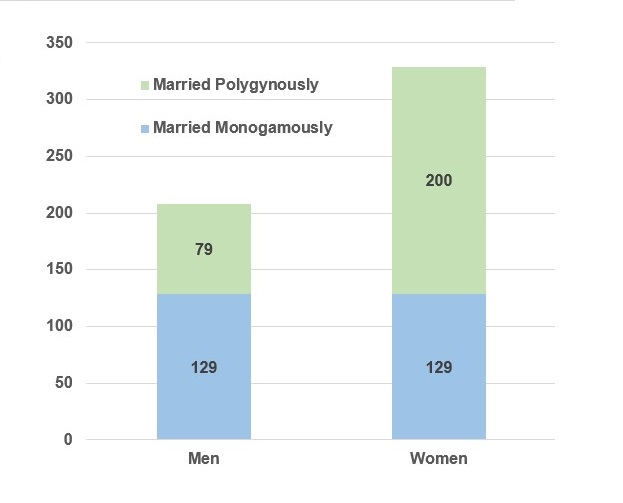
Prior to the cash economy there was a clear upper limit on individual consumption. The primary resource, cattle, was to be used to support people. A man with twice as many cattle as his neighbor was expected to support twice as many people. Since the primary method of acquiring responsibility for others is through marriage, a man rich in cattle was expected, indeed was under a moral obligation, to marry additional wives, no matter his age. The system of polygyny that evolved, which assigns rights in particular cattle (property) to particular people (households), has been termed "the house-property complex" (Gluckman 1950). The principles, as practiced by the Kipsigis, can be stated simply (and will be discussed in detail below).
There are three main ways in which a man can acquire cattle (plus a variety of special means that usually involve only one animal at a time). The first is through direct inheritance from one's father. The second is through bride-wealth. The third, which involves rights to use but not ultimate ownership, is through loan arrangements with cattle partners.
The creation of new homestead units out of the division of those of previous generations must be explained in terms of the rules of cattle inheritance. In his lifetime the typical man will pass through three stages of control over cattle: as a child and young man he is dependent upon his father for cattle and the use of their products; in middle age he acquires individual rights over some cattle while sharing rights in others with his brothers and possibly with his half-brothers; later in life he reaches the point that might be described as individual ownership tempered only by his moral obligations to his sons and descendants. Indeed, the length of a man's life, i.e., his survival in old age, is dependent among other things on how well he has maintained individual control over some of his cattle while yielding control over most of his herd to his various sons.17
For simplicity let us consider first the situation of an old man with one wife. As his sons mature and marry, the father will contribute most or all of the cattle for the bridewealth payments for their first marriages. Ideally each brother should marry in turn, and none should use any of the father's cattle for a second marriage until the youngest is married. This is not always possible, and, when departures are made from his pattern, care is taken to remember the extent to which each brother has made use of the father's cattle. One of the married sons will remain with his wife and children in his father and mother's homestead (where his wife, and their children form another household). Possibly others will stay but will hope eventually to move off to start new homesteads, either neighboring their father's or elsewhere (possibly anywhere else in Kipsigis or even in Nandi). Those sons who move away will be given some cattle with which to start their new herds (tug'ap boiyot, cattle of the elder ). Technically these cattle belong to the old man until the final division of his herd and their ultimate disposition should be approved by the father. In their daily affairs, however, these men are virtually independent, unlike the son who remains with the father.
After the father's death, but before the final division of his property, the sons should (at least according to the formal norms) still consult with each other before disposing of any animal received from the father. The actual division of the herd is not made until after the father's death, and should not take place, ideally, until all the sons have married and established their own households. Until the division is made the older brothers may have actual possession and daily use of the cattle, but hold some in trust for their younger brothers. If a son was not present during the process of dividing his father's herd, and is dissatisfied with the division made, he could claim his share upon his return, collecting a part of it from each of his brother. (As discussed below, age differences in polygynous families greatly complicate issues of inheritance.}
The cattle placed with each son to help him establish a separate homestead are technically no more the property of that son than of another. But proprietary interests naturally develop and so the de facto distribution of cattle that develops during the father's later life becomes the basis for the de jure division of cattle after his death. All inheritance calculations take account of previous use of family resources. What is left to divide after an elder's death is seen as the remainder of the family property (the wise elder retains some cattle to his direct control and does not assign all his assets to his wives' accounts). Among other things, this means that each man keeps track of the development of each of his brothers' and half-brothers' herds and the amount of family cattle spent of behalf of each (in marriages, etc.).
It is considered very bad taste, if not evidence of more malicious intent, to ask about or discuss a man's cattle in public situations. Counting another man's herd is tantamount to cursing it. Yet cattle are the major source of wealth, and although men would not discuss particular cows with me, they insisted that each man in a community could trace the life history of each head of cattle in the community, as well as recognize it by sight. As one old man put it:
Even after the formal division of the father's herd (full) brothers are under certain moral obligations to one another concerning the cattle they have inherited. At any point one of them can make a claim involving tug'ap boiyot. Settling such a claim would involve assembling the men who were originally concerned and reviewing the life history of the cow or cattle in question, and its place in the original division. Moreover, should all of the cattle in one brother's herd die, he could appeal to his brothers. In almost all cases they would each give him at least one animal. This however is considered an outright gift rather than a loan or a readjustment of the original division and is an example of a man's moral obligation toward the welfare of his brother's house (in a sense similar to assuming the duties of a leviratic marriage discussed below), rather than a binding obligation for which one could be held responsible in either traditional adjudications or current courts. Similarly, though an old man has a moral duty to look after his cattle for his sons, formally he has the power to disinherit any of them (or even the power to squander his resources).
Once an elder has reached complete agreement with his brothers over the disposition of their father's cattle (including marriage cattle discussed below), such a man is the head of an independent cattle owning family unit and is thus the sole owner of the animals which he will eventually pass on to his sons. If a man feels that his brother's cattle are not being handled properly he can only offer advice; if the division has been made he has no claim to interfere beyond that.
The division of property between brothers is final in their generation. No claim for readjustment of the original division can be made between their sons, patrilineal first cousins.18 In terms of rights to cattle, cousins are no more obligated to one another than mere clansmen, whose help is never fully binding.
The rules of inheritance result in a great number of different combinations of family units "on the ground." The variations in residential patterns combined with the variations in the timing of property division in a man's life make it impossible to judge by an application of the formal rules to any single observation (e.g., the number of people or generations represented, or the age of the eldest male) whether a particular homestead is an independent cattle owning unit, or some part of a larger unit. In each case details of the family history (and the life history of a large number of cattle) must be known if one is to understand the extent to which the people of a particular homestead form an independent unit. This indeterminate situation is positively valued among the Kipsigis, and a great deal of attention is given to keeping track of the situation among one's relatives and neighbors, and to obscuring such details from strangers.
One of the most important complications of the inheritance rules described above arises in the case of polygyny. Each of a man's wives, with her children, function as an independent economic unit within the larger group, and that in matters of inheritance, the sons of one wife stand as a unit against the sons of her co-wife. In polygynous families an extra level is introduced in matters concerning the family cattle. Just as the distribution of cattle for use by the grown sons of an old man foreshadows the nature of the division of the old man's cattle after his death, in polygynous situations certain cattle are assigned to each wife for her use as her children grow up and these cattle (or their offspring) form the basis for the eventual division of property among the houses (sets of full brothers). In polygynous families the eventual division of property thus goes through two stages. First the property is divided equally by "house" (regardless of the number of sons in that house), and then within each house divided among the full brothers as it is in a monogamous family.
Thus, if the father's total estate amounted to 36 cattle, (both those previously assigned to wife's houses and cattle under his direct control), the unassigned cattle should be distributed such that each son inherits (or has already received) the number shown in this sketch:
Division of an Elder's Cattle (Tug'ap Boiyot)

The division of property by houses makes the accumulation of wealth in particular families unsustainable across generations. Table 2-3 compares the marital status of 59 men in the interview sample (discussed in detail in Part 2), with their fathers' marital status. In conjunction with the rate of polygyny shown above in Table 2-2, a number of features become clear:
- A majority of men have only one wife, yet
- a majority of women have a co-wife.
- A majority of sons have fathers who are polygynists, yet
- less than half of them will become polygynists.
- Indeed, they are no more likely than the sons of monogamists to become polygynists.
- In short, there is no relationship between fathers' and their sons' marital status (which is a direct indication of wealth in cattle).
| Fathers | |||
|---|---|---|---|
| Monogamous | Polygynous | ||
| Sons | Monogamous | 11 | 25 |
| Polygynous | 6 | 16 |
The dominant social values clearly reflect the challenge facing men regardless of their childhood circumstances. It is recognized that sons may tend to look upon their father's wealth with envy (kibai chi, kosich kong', feed a person, get an eye ) and, in their selfishness, cause conflicts which are counter-productive for the family's resource base which ultimately made their existence possible (tet' ki i maa, the cow gave birth to a fire ). The popular caricature of a son raised in the home of a father who has achieved wealth is that of a person lacking in personal ambition and eager to fight for the spoils of his inheritance among his many competitors (ki i ng'etuny lel, a lion gave birth to a jackal ). In contrast, the qualities required to become a self-made man are highly esteemed and strength of character is considered to be forged through adversity (ma kisasunen karna maa, do not despise an iron in the [blacksmith's] fire ).
Polygyny influences family dynamics in a number of ways. First, one direct result of polygyny is that it reduces the amount of interaction between the husband and the members of one or both of his houses. This is especially true when co-wives are not co-resident. Unlike the Bantu-speaking groups in highland Kenya among whom agnatic lineages or clans share rights to land, and residence is patrilocal (on a smaller or larger scale depending upon which group is being considered), Kipsigis homesteads are individually owned and descent groups are dispersed. Prior to land enclosure all but one son in a monogamous family would leave the parental homestead upon maturity; following enclosure such dispersal was still practiced as much as possible in order to avoid subdividing plots. At least until very recently this has been possible in almost all cases through the enormous expansion of the relatively dense pattern of domestic settlement in previously open areas. While many men may initially establish their second wives on the same homestead as their first, the principle of the house-property complex leads directly to a situation of potential competition between co-wives. Thus many man find it preferable to establish different wives on independent homesteads in separate communities. This becomes increasingly imperative as sons mature and sets of half-brothers become aligned against each other. If at all possible, co-wives should be established on separate plots, each with a son who will provide for her to her old age, before their husband dies. While this may not always happen, I know of no cases of widowed co-wives who live together. Although the timing of separating co-wives varies in different families, at any one time there are a significant proportion of women with children living some miles from the usual residences of their husbands. (For a detailed discussion see my paper Residence Rules and Residence Patterns in a Kipsigis Community).
Polygyny causes great variation in the nature of the homestead group, and in the cattle sharing group (which may or may not be scattered geographically) because the great age differences that result between members of "structurally equivalent" houses. In the past all women were married at the end of their initiations. Even today all but a few are married before the age of twenty. First wives tend to be at least a few years younger than their husbands, and junior wives are younger than senior wives. It is not uncommon for co-wives to be at least a generation apart in age. In one case, among the children of a man with three wives, the first born was a grandmother while her youngest half-sister was an infant. Four quick examples illustrate the diversity of situations that can arise:
- Arap Mibei is hearing-impaired. His father arranged for him to be initiated at age thirteen and married immediately after emergence from seclusion. At age twenty he has a wife and three children, aged six years to three months.19
- Arap Kilel happened to be the only son born to one of three wives of an elder with many cattle. He also had the good fortune to have three older sisters. With a clear claim on his inheritance and the receipt of three marriage payments, he married first at age seventeen, and a second time at age twenty-one. At age 26 he felt overwhelmed by his responsibility for two young wives, one with four children, aged seven to six months, and the other with two children four and one years old.
- Arap Rotich's father had six wives. But with two brothers to share his inheritance, he struggled and finally married at age thirty-six.
- Arap Bet is an elder with a wife and eight children, the oldest a married daughter, the youngest an infant son. Now, at age 56, he has married a young teenage bride as his second wife.
Much of the conflict which arises between members of one "family" are due to such age differences taken in combination with the issue of de facto or de jure divisions of property. According to the formal rules a sixty-year-old man may still be holding cattle in trust for eventual division with his half-brothers from another house, while such a half-brothers may in fact be infants, or as yet unborn, or the male heirs in the junior house may even be one more generation removed because of a woman marriage (explained below). In practical terms such a situation is unworkable, particularly in a society in which it is quite possible that an eighteen-year-old man at the next homestead is the sole owner of cattle received from his father who dies young. The temptation is for the members of the older house to take advantage of the younger house, especially if it does not yet contain any adult sons,when parceling out the family cattle.20 Such situations also place unusual demands on women who may have to hold their position as best they can against a co-wife's sons. It thus becomes a point of contention in many Kipsigis families whether the physical distribution of animals among the various homesteads will or will not be the final, formal division of cattle to be inherited. The question of defining the boundaries of the family, if the term is taken to mean the people who share rights to inherit from one man's estate, is not merely an analytical problem but an empirical social issue faced by many, if not most, Kipsigis.
Usually bridewealth cattle include an ox or two and occasionally a young bull. The majority of the animals exchanged, however, are females, unbred heifers and cows. If a cow is accompanied by a nursing calf, the calf is not counted in the total number of animals said to be transferred. In addition most exchanges include smaller stock, ng'ororek (sheep and/or goats), and in recent years cash and perhaps some purchased trade items.
Traditionally one animal counted in the bridewealth payment has a special status. Known as the chebletiot (cheb-, female prefix + let to come last, i.e. 'the last one'). Though usually a female calf, this may be a she-goat or ewe. This animal remains with the groom's family for perhaps a few years after the marriage. When the marriage has resulted in a healthy child or two, the chebletiot is finally sent to the woman's family. For the Kipsigis one is only really married when one has children. One of the offspring born to the chebletiot during this intervening period is retained by the man's family as a manifest sign of the tie between the two families.
Table 2-4 lists the number of bridewealth cattle reported to have been paid in forty-one marriages involving families in Kapsuswek.21 In addition to cattle, a few to a dozen small stock (sheep and goats), were transferred in most marriages, but their numbers do not show any historial trend. The amounts of cash and trade goods were not specified in many cases and so are excluded from the table, though their value has undoubtedly increased significantly as the Kipsigis became more and more involved in the cash economy. Even without this information, however, it is clear that the value of bridewealth transfers has increased, especially between 1945 and 1960.
Number of Cattle Transferred in 41 Marriages
Involving Families in Kapsuswek Community
1918 - 1972
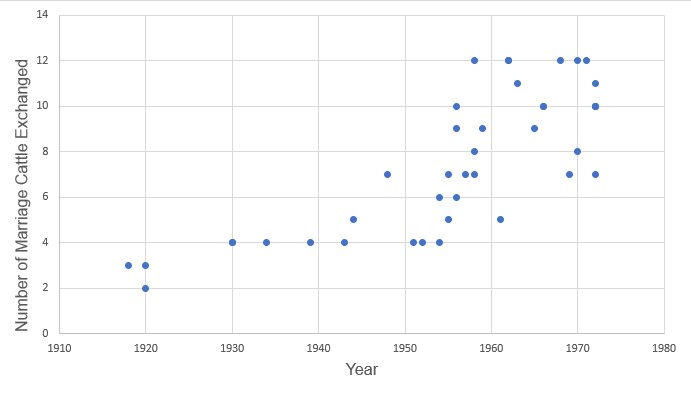
In a sense, each of a man's houses holds a franchise in the family business, and separate "accounts" are kept, by house, for cattle given and received in marriage. Tug'ap koito are controlled by the bride's father, if alive, but belong ultimately to the bride's full brothers. An old man can, for example, take two animals from his first homestead to give as part of the bridewealth to marry a son from his second homestead, and may even accomplish this without creating rancor between his two sets of sons, but when the division of his legacy is calculated, the sons of the first house will contend, rightly, that this expenditure of two head is to be refunded first.
Similarly, cattle received for the marriage of a daughter in one house are to be used for the benefit of that house only. Their preferred use is for her full brothers' marriages, though they can also be used legitimately for the support of her mother and siblings and, today, for such expenses as school fees for her brothers. Under no circumstances should cattle received in a daughter's marriage be used for the personal benefit of her father or half brothers in another house. Were these cattle to be used by the father for a further marriage of his own, or by the half brothers for marriages in their names, this would amount to taking the profits from one branch of the family to establish another franchise, or strengthen an existing one, which would be in competition with the first for the final division of joint property. To establish a new household on such a misuse of cattle, even if it were possible to do so by concealing the true facts from the bride's family and others, would invite inevitable disaster.
But the exact determination of each individual's identity within a particular family is critical, and the definition of paternity is therefore simple and iron-clad, or more exactly, cattle-bound. Marriage involves the transfer of cattle from the groom's family to the bride's. The person in whose name the marriage cattle are given is, by that transfer, the socially recognized father of all children born to the married woman.
Anthropologists have adopted two Latin terms to differentiate the two potentially separate aspects of fatherhood:pater refers to the socially recognized father, the person whose marriage to a child's mother bestows legitimacy on that child. Genitor refers to the physiological sire of the child.
Ethnographies from the colonial era often translated indigenous terms for cattle or other property exchanged in African marriages, e.g.tug'ap koito, as brideweath or "brideprice." Bridewealth should not be confused with its opposite, dowry, which is propertry the bride's family brings to the husband at marriage. "Brideprice" is more problematic since to the modern mind it suggests women are somehow the subjects of commercial purchases. The confusion is two-fold. There are, at times, market considerations in setting the amount of property involved.22 The deeper issue lies in translation. In Kalenjin the verbs ke-al and ke-alda, which long antedate any formal currency, mean to receive in an exchange and to give in an exchange (-ta/-da is a suffix indicating movement away from the speaker). These words are now used, quite naturally, to mean "to buy" and "to sell." But wives are not bought or sold. What is exchanged for the tug'ap koito is, in technical terms, rights of filiation (from Latin filius, son, filia, daughter), that is the husband's right to claim the bride's children as (his) sons and daughters for all matters of inheritance and future marriage, thus establishing the primancy of patrilineal descent. It is this particular sense of paternity that is transferred to the bridegroom's family by marriage.
In America a determination of "paternity" [as in the courts] is a search to identify the genitor, in East African pastoral societies "paternity" is concerned with determining the socially defined father, the pater, the person from whom the child derives his or her identity in the family and thus in wider society. If thepater and the genitor are two different people, our courts expect that in general biological events should be used to define legal and financial obligations, while the Kipsigis (who after all breed animals and have no illusions about reproductive behavior) hold that kinship is fundamentally social and moral.
It is expected that in a usual marriage a man will enjoy exclusive access to his wife's sexuality, and thus will be the genitor as well as the pater of all her children. It is also well understood that this is not always the case. Most obviously a discrepancy can arise in situations of adultery. As disruptive as such events may be to personal relationships, legally it does not matter whether the husband suspects his wife has "found a baby in the bush" (rather than in his bed) or whether she has left him and lived openly with another man for years. Non-coresident polygyny provides many opportunities for adultery, of course, and no doubt in some extreme cases involving very old men who have married six or seven wives as a means of reinvesting cattle, it is quietly accepted.23
I know of a few instances in which a marriage was annulled and the young woman subsequently remarried, and successfully bore children. In a few other cases a woman with children has returned, or been returned, to her natal home, but her husband was unable to recover his cattle (a father should not shelter both his married daughter and the cattle given for her marriage).
As long as the marriage remains formally in force, the husband is the socially recognized father of all children born to the wife. The alternative, divorce, involves the return of the marriage cattle (including, in theory, any calves born to the cows since the exchange) to the husband. It logically follows, therefore, that a husband who accepts back marriage cattle thereby surrenders claims to paternity over all (past, present, and future) children of the wife being divorced. The critical moment in a traditional divorce ceremony comes when the man and woman anoint each other (ki-ilge). As with other moments of anointment, for example at the start of initiations, this marks a change their social status. They then address each other by their childhood names (e.g. 'Kiplang'at', 'Chebkemoi') thus ending their observance of respect for each other.
However, once a couple has a child, the difficulties involved are such that divorce is resorted to only in rare and exceptional circumstances. It also follows that once a son has been initiated, his mother cannot be divorced. Having been given an adult patronym, Arap X, the son of X, his inheritance or even his life may be taken from him but his paternity cannot be denied.
I know of only one case in which a woman with children was formally divorced and remarried (the case of Arap Chesimet, discussed below). Apparently it is nearly impossible for a husband to recover marriage cattle from his wife's family long after the marriage unless they in turn acquire cattle to compensate him by accepting a second marriage transfer from another party. As Orchardson comments (1961:79): "The object of divorce is to allow the woman to marry again." Thus (at least prior to urban life) there were no single divorcées.24
If one considers marriage to be a relationship between a man and a woman, then the determination of paternity by cattle transfers rather than the events of human physiology may seem rather arbitrary, adding an unnecessary rigidity to the terms within which inevitable interpersonal problems must be handled. And undoubtedly there are Kipsigis who feel at time that the rules of their culture are maladaptive for the individual. Marriage among the Kipsigis, however, is not a contract between two persons but between two families. The definition of paternity is a reflection of the essential requirement of the system to preserve a continuous and unambiguous pattern of associations between families and herds. This can be seen more clearly when one considers the question of paternity in the context of two other basic principles of marriage in traditional Kipsigis society. First, everyone should get married. No other role choices were available.25 On this there is universal agreement among my informants (and earlier accounts). Even in cases of abject poverty, marriages were achieved by elopement or the promise of some future transfer of bridewealth. In all my genealogical records there is only one case of an adult who remained unmarried, a man described as severely retarded. The deaf and dumb, the blind, the crippled, if they survive childhood, marry.26 Second, no healthy woman should be denied a normal career of motherhood.27
Once married, a woman is assured of the legitimacy of all her children. Children, especially sons, increasingly validate her place in society and contribute in her later years to her moral and physical support. Should a man be unable to make his wife pregnant, it is his responsibility to arrange, or at least condone, a relationship that will produce children. Refusal to do so would amount to discarding the wife's future (as well as his own), and is one of the clearest grounds for divorce that women have.
Secondly, the competitive nature of polygyny reinforces the value that each marriage should result in a separate "house" with one or more sons who will eventually inherit a part of their father's cattle. This in turn can lead to particular marriage practices which, if successful, result in creating male heirs in the house in question.
In keeping with the understanding that marriage is not a relationship between two individuals but is a connection established between two families, marriages continue after the death of the husband's death. In anthropology the levirate or leviratic marriage usually refers to situtations in which a widow marries her dead husband's brother. But as the Kipsigis handle this situation, when a married man dies, his wife does not remarry; her marriage to her original husband continues until her death. The deceased's brother or other suitable close agnate (who must be of the same age-set as the deceased) becomes responsible for continuing to husband the widow and her household on behalf of the deceased. The husband-surrogate is known as the kipkondit (kip-, the male prefix + kondo, eye, hence `male supervisor'). Since the original marriage remains in force, if the widow is young she may bear further children by this man. They are the sons and daughters of the deceased husband. Thus one's pater could have died years before one's birth. (Hence the practice, mentioned earlier) of having ailing boys initiated and married early.)
A man assumes the role of kipkondit in addition to his own marriage or marriages; this responsibility in no way diminishes his desire to marry on his own behalf nor his claims on family cattle to do so. The extent to which the kipkondit interacts with the widow and her children on a day to day basis varies according to such considerations as her age, and hence the extent to which she conducts her personal life independently of her husband's family, and her proximity to the kipkondit's residence. However such details are handled, the formal definitions of marriage and paternity guarantee the rights of all concerned, including the unborn, to their proper share of the family resources.
In Kalenjin this arrangement is called kotunji toloch which literally translates as to marry ko-tun someone -ji, or -chi [as a] house post toloch - the center post supporting the main rafter beam inside a house ('someone' here implies a bride; in the Kalenjin language, men marry women, women are married by men). the phrase kotunji toloch is a metaphor for shoring up a "house" in danger of collapse, in this case not architectural but social collapse. This practice was unfortunately labeled "woman marriage" in the colonial literature, and I have used that term here with reluctance. A far better term in English, I suggest, would be "daughter-in-law marriage."
While the terms for husband and wife, or bridegroom and bride, are useful for explaining the roles of the old woman and the young woman, these terms are not used in daily speech. Technically the children's pater is the old woman in her role as the old man's proxy. But unless one inquires specifically about the situation, it is not evident from daily behavior or the use of kin terms that the relationship between the two women is technically that of husband and wife rather than that between an old woman and her widowed daughter-in-law. The young woman refers to the old woman and the old man as her mother-in-law and father-in-law (she addresses them as the familiar term for mother, and the formal term for father, as any daughter-in-law would). The young children call the old people grandmother and grandfather (viz Peristiany l939:8l-83; Orchardson l96l:78). A casual visitor, coming to a homestead in which a grandmother lived in one house and her daughter-in-law lived in another just yards away, with children running about, would not know by anyone's behavior whether the younger woman's husband was momentarily off at the shops, or a migrant laborer, or deceased, or never actually existed.
The practice of kotunji toloch was still common during my research in the 1960s. There is no difference from a more regular marriage in the amount of marriage cattle exchanged. There seems to be no shortage of brides willing to be involved, indeed I suspect some prefer the partial freedom of being an 'instant widow' with a part-time supervisor over an arranged marriage to a full-time husband. In the short run the arrangement provides a daughter-in-law who will hopefully see to the old woman's care in her old age. But this is not a way to care for old widows. Most significantly, in every case for which I had information, kotunji toloch marriages occurred in families in which the elder was still alive, and had at least one other wife who had adult sons. For the elder, there is the compelling motivation of continuation of a branch of the 'family business.'
Kipsigis social principles are the products of an evolved (and for the most still very real) dependence upon cattle. Formal relationships of descent and affinity are shaped by the fact that they carry heavy implications about family herds. Priority is necessarily placed on norms which favor the support of existing units of ownership and a viable distribution of resources among them. Issues such as paternity are contractually defined because they are too vital to leave to the errors or misfortunes of individual lives. Through marriages households are established which identify certain people with certain resources. As the practice of the 'leviratic' extension of marriages shows, once such an investment has been made there is every reason to promote its continuation. Indeed the usual definitions of gender and descent can be formally manipulated, when necessary, through "woman marriage" and "daughter adoption", to maintain family lines. The demand that each house contains at least one male heir thus produces situations in which one's father (pater ) can be a young adolescent, a sterile or impotent man, a very elderly man, a man long dead, one's grandmother, or one's mother.
In principle the rules concerning the distribution of inherited cattle and marriage cattle are easily stated. In practice, as these rules are applied in particular families with differing numbers of sons and daughters, they generate patterns whose complexity quickly goes beyond the available data. Nonetheless the major implications of these rules for the flow of property in Kipsigis society can at least be suggested.
To begin with, the number of cattle a man acquires which are primarily intended for his use as bridewealth is a function of the number of his full sisters (the number of marriage payments received by his house) compared to the number of his full brothers (the number of men with whom these cattle must be shared). It follows that men with more sisters than brothers are more likely to have the cattle necessary for second marriages (because the cattle involved in a marriage exchange amount to a significant proportion of a typical family's wealth: roughly a third of the number of animals on the average homestead in the more pastoral zone). Among the 58 men in my interview sample (discussed in detail in Chapter 7), 26 had more sisters than brothers, and of these men 14 (54%) were polygynists. Among the 32 other men with as many or more brothers than sisters, only 9 (28%) were polygynists.
The accidents of birth within sibling groups play a major part in determining who accumulates cattle. Early in my fieldwork I attended a beer party given by a very old man who had started life with little and through warfare, trading, and shrewd management ended up with many cattle, three wives, and several sons. Another elder at the party, a rather cranky, humorless character had a daughter married to one of the host's sons. This elder was thus accustomed to being given the place of honor in this house. During the colonial era he had some bad experiences at the hands of the British, and was convinced I was up to no good. He attempted to dominate the discussion, demanding that I explain my presence. Although I was quite willing to do so, my host took offense, instructed me to remain quiet, and told the other elder that he was overstepping his rights as a guest. After repeating the demand and being rebuffed by the host two more times, the other elder stormed out of the party in a huff, and the host turned to me and said "Don't pay any attention to him; he thinks he's a big man but he simply had a lot of sisters."
However a man acquires cattle, when their number exceeds a certain level he is likely to take another wife, reinvesting cattle in further dependents (although few men achieve the sustained success necessary for three or more marriages). Moreover, different men undoubtedly recognize different thresholds at which they choose to expend another bridewealth payment and start capitalizing another house. This introduces still more variance into the amounts of sons' inheritance. Thus the sons of a rich man are not likely to start their own careers with any particular advantage. The amount of cattle a man receives from his family of origin depends, for tug'ap boiyot, upon his father's wealth, the number of his father's wives, the timing of his father's marriages, and the number of his full brothers, and for tug'ap koito, upon the ratio of sons to daughters in his mother's house. To these basically unrelated variables must be added, of course, the many vagaries of animal husbandry itself.
In the aggregate, each generation benefits from the pastoral accomplishments of the previous generation. But traditional relationships between cattle and individual lines of ownership have sharply different implications for the two sexes. From the point of view of dependents, women and children, the requirements of raising a significant amount of bridewealth and initial capital to establish a new house means that brides are sent to those families which demonstrable have the extra resources to support them. Since marriage was universal (and in this comminity still expected of everyone), it is true that some women are necessarily married as the sole wives of men with few resources. But not all monogamists are poor (quite aside from those who are monogamists for modern reasons). It is highly unlikely that a man would contract a second marriage without adequate resources for both houses. When these considerations are combined with a high rate of polygyny, it is clear that in the vast majority of cases, people were, at last before the cash economy penetrated deeply into their lives, being matched with resources. The effect of bridewealth, polygyny, and the various rules comprising the "house-property complex" maximize the benefits derived from family herds by allotting rights to use their products far more equitably among women and children than the fluctuating patterns of their formal ownership among men. For men, however, these practices continually lead to random inequalities. Differences in acquired wealth mean that there will always be some willing to take large risks to acquire cattle from outside the society, while the instability of wealth in patrilines means that a high degree of interdependence has to be reestablished in each generation.
The third major system of rights to cattle is called kimanagan, or cattle given on loan. The loan arrangements are not directly related to family composition. Briefly, a cattle loan gives the recipient rights to the products of the cow (and any calves born to her) in return for her care and feeding. Although a man may on occasion send a wife or child to a man to whom he has lent cattle to collect milk from those animals (if, for example, he will be hosting a large gathering for an initiation or marriage), he cannot ask for their return on short notice or in an abrupt manner.
Loans are not made between patrilineal cognates or affines since these relationships already involve rights to cattle that may interfere with a loan arrangement.
Kimanagan loans function to redistribute cattle more evenly among different homesteads and different areas. By spreading his assets in different areas, the lender (komonoktoindet) insures against the loss of all his cattle by any local catastrophe (drought, disease, enemy raids, seizure for murder compensations, or whatever). He also gains some secrecy in the management of his estate, which can be usefully played against his wife's or wives' attempts to gain de facto control of cattle attached to a particular "house."
The recipient of an animal is expected to care for her responsibly, but is not blamed if the animal dies for reasons other than might arise through negligence. He is bound to report the death of the animal to its owner, usually by sending him the hide (for positive identification). When a man dies, all those who hold his cattle in kimanagan are morally bound to report the exact status of the loan to the deceased man's chosen son (even if the son is ignorant of the extent of his father's loans). All of the old men who discussed kimanagan arrangements with me were adamant in stating that any attempt to conceal such matters from the rightful owner or heirs of the cattle would result in divine retribution being visited upon the dishonest man's family. They could all cite cases they had known to support their view.
Before an elder dies he is expected to inform his favorite son (most certainly the one who lives with him) of the details of every kimanagan arrangement in which he is involved, both as a lender and as recipient. The favorite son is thus, in a partial sense, the executor of his father's estate until the time of the final division of property among the heirs. Knowledge of kimanagan assets and debts is a sacred trust that must not be used to take advantage of the other heirs.
While this system of cattle loans serves to integrate Kipsigis society, it greatly complicates the discussion of family and homestead economics. Although it is doubtful if any man ever has as many as half of his cattle out on loan, it is extremely unlikely that the herd of cattle on any one man's homestead (even that of an independent elder) are all his cattle and only his cattle. Throughout the above discussion of cattle ownership and family organization, where the term "herd" has been used, this should be taken to mean the total assets of the head of the household, and not the herd in the sense of the animals that are physically herded together at the homestead.
Distinct from any consideration of inheritance as discussed above, a son may receive one of his father's cattle as a reward or as a sign of approval for some accomplishment. The father would probably select the animal from his personal herd, though he could, at the risk of provoking friction, take any animal which he had assigned to another son. The other sons have no rights whatsoever over the gift animal, and it is not counted as one of the tug'ap boiyot to be divided among the heirs after the father's death (there is no special term for an animal given to a son in this way).
Another type of gift occurs when a son or daughter leaves initiation seclusion. It is customary for the father to present the initiate with an animal to show his pleasure. A young bull or steer is the usual form of the gift, and is called tet'ap korokto, the cow of the walking stick, because of the association of the gift with a walking stick cut from a branch which the initiate carries when leaving seclusion. These animals become the personal property of the recipients. For daughters emerging from seclusion the gift is usually a female calf. A female calf, sheep, or goat is usually given to the woman who performed a daughter's initation as well. These are the only instances of outright cattle ownership by women (some women acquire caretaker rights to cattle if they have no husband, as in cases of women marriage or "daughter adoption”). Even in the case of a gift to a daughter (soon to be married), if the woman's husband proves to be a domineering person (which is something of the Kipsigis male ideal), he may assume complete control of the animal. In some instances may even slaughter it for his own purposes (which the Kipsigis logically consider the ultimate right of ownership).
| December 31, 1966 | June 30, 1972 | ||
|---|---|---|---|
| Living at Home | Full Time | 211 | 236 |
| Part Time | 3 | 8 | |
| Absent | Migratory Workers | 1 | 12 |
| Dependents of Workers | 0 | 4 | |
| For Personal Reasons | 3 | 4 | |
| Children Visiting Relatives | 1 | 1 | |
| Totals | 219 | 265 |
Changes in the Population of Kapsuswek
Between December 21, 1966 and June 30, 1972
| Increases | Decreases | ||
|---|---|---|---|
| Births | 63 | Deaths | 7 |
| Brides, married in | 5 | Brides, married out | 7 |
| Immigrants | 5 | Emigrants | 13 |
| Subtotal | 73 | Subtotal | 27 |
| Total net incease | 46 |
| December 31, 1966 | June 30, 1972 |
|---|
| Males | Females | Males | Females | |
|---|---|---|---|---|
| Married Adults* | 32 | 47 | 37 | 57 |
| Young Unmarried Adults |
13 | 0 | 16 | 2 |
| Uninitiated Children | 72 | 55 | 82 | 71 |
| Subtotals | 117 | 102 | 135 | 130 |
| Totals | 219 | 265 |
The most striking feature in these comparisons of census data is clearly the high rate of natural population increase. In addition, these data suggest in several ways the increasing involvement of community members in economic change which are widespread in Kenya.
In 1966, two of the part-time residents were men who regularly divided their time between their families in the community and second wives in distant communities (a middle aged man who spent the majority of his time in Kapsuswek because of local employment with the government, and an elder who stayed in the community for short periods every few months in order to remain active in events involving his relationships with several of his neighbors). The third part-time resident was a very atypical old woman who came and went at seemingly random intervals (see the description of Arap Tesot's household, below). By the middle of 1973, five others were spending large amounts of time outside the community: two men, both monogamists, who were developing farms elsewhere, another who was spending the work week running a shop a few miles away, and two young unmarried women attending schools outside the community.
Although almost all the older men in the community had spent part of their early adult lives in migrant wage labor, only one member of the community was working outside the district in 1966 (serving in a branch of the security forces stationed in Nairobi). Several other young men, living at home, were engaged in casual labor locally. By 1972 the man in Nairobi had moved his wife and three children to the city, clearly a temporary arrangement made possible by a relatively high salary, government housing, and job security. The eleven other men absent in wage labor represent the more usual pattern of individual workers trying to raise money to finance their first marriages back in the home area (three men), or to support a young family that remains home (eight men, four with young children). Eight of these men were working on the tea plantation in the northern part of Kericho District. The three others were in Nairobi.
Age-Sex Pyramid, Kapsuswek Community
June 30, 1972
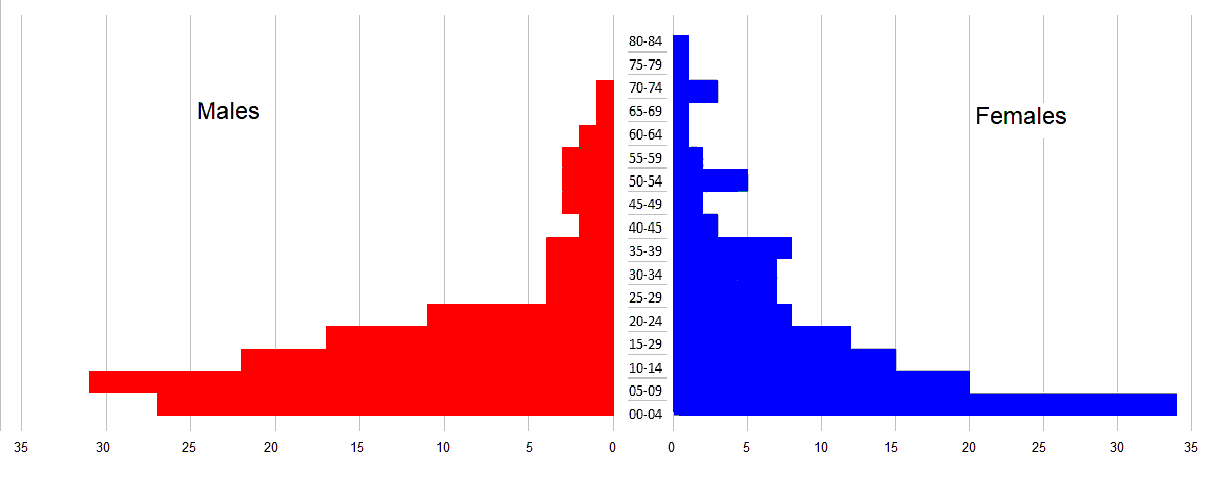
While one community is much too small a sample to allow accurate estimates of overall demographic patterns, the age-sex pyramid of Kapsuswek suggests the high birth rate that characterizes the Kipsigis, and indeed the highland populations of Kenya as a whole. The median age in Kapsuswek in 1972 was an astonishingly low 13 years. During the five and a half years between census dates, 33 women in the community gave birth to 65 children, 27 boys (all of whom were surviving in June, 1972), 37 girls (two of whom died in early infancy and one child who died of accidental injuries at approximately one and a half), and one child who died in infancy for whom no further details were reported. In addition to these four infant deaths, two men, aged 65 and 69, and one boy, age ll, died during the interval between censuses.
| Males | Females | ||||||
|---|---|---|---|---|---|---|---|
| Age in years |
U | I/NM | M | U | I/NM | M | |
| 23 | - | - | 1 | - | - | 1 | |
| 22 | - | - | 2 | - | 1 | 5 | |
| 21 | - | 2 | 2 | - | - | - | |
| 20 | - | 5 | 2 | - | - | 1 | |
| 19 | - | 1 | 1 | - | - | 2 | |
| 18 | - | 2 | - | - | - | 5 | |
| 17 | - | 1 | 2 | - | - | 2 | |
| 16 | 1 | 4 | - | 3 | 1 | 3 | |
| 15 | 1 | 1 | - | - | - | 2 | |
| 14 | 6 | - | - | 4 | - | - |
Some further aspects of the demographic situation can be seen in Table 2-9, which shows the initiation and marital status of young people in the community by sex and by age. Traditional polygynous marriage practices defined wives as dependents and husbands as those who must raise high bridewealth payments. Prior to the modern era, all females were married shortly after initiation, while males typically spent several years between initiation and marriage. Table 2—10 clearly shows the continuation of this pattern. Yet while the overall rate of polygyny is still high (details of the extent of polygyny among a large sample of marriages are given below in Chapter 6), a number of changes are occurring in marriage patterns. Many older informants said that the typical age of initiation and marriage used to be older for both males and females. Data from a larger sample (the 58 subjects in the interview sample discussed in Part 2) indicate that since the early 1950s boys are being initiate before age 17. but in general show an average age of 14½ to 15½. Although the census data from Kapsuswek includes only a small number of younger women whose ages area known with reasonable certainty, they also suggest a slight decline in the age of initiation for girls in recent years.30
More relevant to the question of demographic change in the community is the age at first marriage, which is surprisingly low for both sexes.
| Age in Years | 14 | 15 | 16 | 17 | 18 | 19 | 20 | 21 | 22 | 23 | 24 |
|---|---|---|---|---|---|---|---|---|---|---|---|
| Males | - | - | 2 | 4 | 2 | 4 | 2 | 3 | - | 1 | - |
| Females | 17 | 6 | 15 | 7 | 4 | 1 | - | - | - | - | - |
In some cases these marriages represent a continuation of traditional patterns. By June, 1972, only one of three young men, who had received a large number of cattle through family circumstances, had taken a second wife. On the other hand, five of the young women were married as second or third wives, three others were married to old women, and two others were first wives of men who had subsequently married again. While it is impossible to say how many of the remaining 24 women, who are currently their husband's only wives, will have younger co-wives in the future, I doubt that the rate of polygyny among them will equal that now found in older generations.
It is difficult to establish trends in a population for which age estimates for middle~aged and older people can be determined only within a range of a few years for men (by using age-set and sub-set identities) and only within a range of several years for most women. However, the above data on younger people indicate that men are now marrying at an early age (i.e. most brides are first wives of men not much older than themselves).
Further, comments made by older people when discussing such cases reveal that an increasing proportion of marriages are not arranged by parents but result from attachments made between young people on their own. Several marriages in recent years took place because of teenage pregnancies. Traditionally, most people felt that children born to uninitiated girls should be killed at the moment of birth, before the first cry which indicates that the child has embodied the spirit of a dead ancestor.31 Such drastic action was clearly a last resort and was not always taken: one old woman, whom I was interviewing about traditional patterns of childrearing, described this practice and then immediatedly added "well, that was what was supposed to happen, but many girls managed to keep their babies." She knew several cases in which the girl kept her child and later married, after initiation, thus establishing the child's social paternity. The more usual solution to the problem of teenage pregnancy, which is now followed in Kapsuswek, is to initiate the girl while pregnant and hold a marriage ceremony before the birth.
The two young women in Kapsuswek in 1972 who had not yet married, although initiated, were in secondary schools, the younger in the first year of a Harambee (community self-help) school a few miles away, the older in the third year at Kipsigis Girls School in Kericho. These cases are the first sign in Kapsuswek of a trend that was well established years before in the more prosperous areas of the district where a growing minority of young women have forsaken early marriage and the role of a farmwife for the new educational and employment opportunities (both good and bad) to be found in the towns. The people of Kapsuswek have not yet had to face the problem, which is anomalous by traditional categories, of a child born to an initiated, but unmarried mother.
A few highly educated young women among the Kipsigis have forgone initiation altogether. This had not yet happened among the families in Kapsuswek by 1972, although one homestead did have two female cousins elsewhere who had announced that this was their intent.32
The distribution of people by homesteads is given in Table 2-1133 The average number of people per farm was 9.1 in 1966 and 10.6 in 1972. The most divergent cases are particularly interesting. The homestead with only three members is composed of a husband, wife, and young son. As it happens, the wife, though young, is unable to bear any more children, while her husband, the only man in the community to attend church regularly, is also the only man to express a commitment to monogamy on religious grounds. During the period of study they hosted one or two young male relatives who attended the nearby school and assisted in chores. The largest homestead group, with eighteen members, consisted of a man, his two wives, and their children, only one of whom was initiated in 1966. In 1967 this man purchased half of an adjacent farm (i.e. 15 acres) when its owner left Itembe, and a few years later moved his younger wife and her children to another community. At no time during the fieldwork were all of the children of this homestead observed at home together. Following the usual practice, some children stayed for short periods with nearby relatives and friends.
Frequency Distributions of Homesteads
by Size of Homestead Group
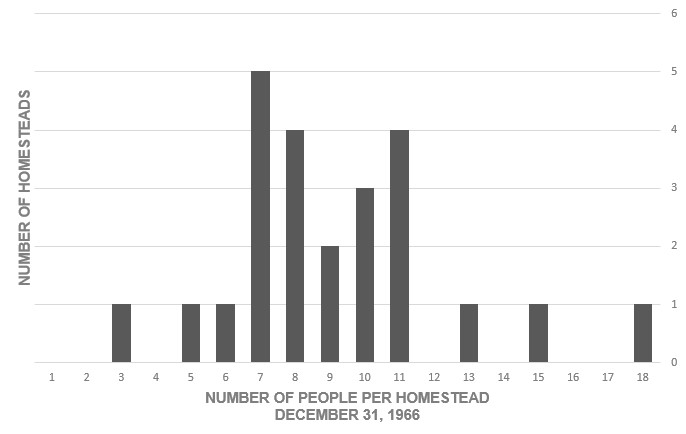
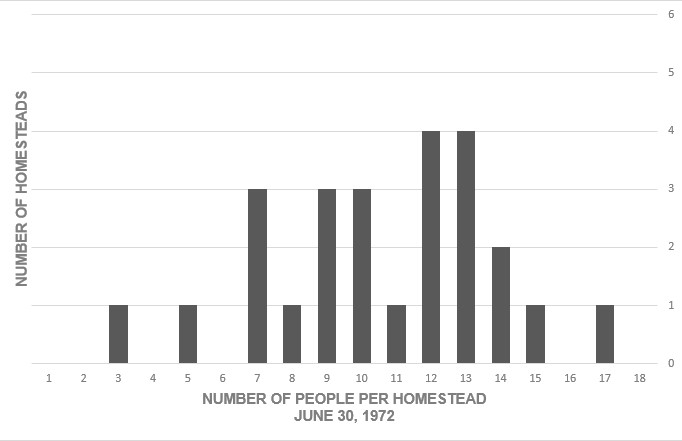
As Table 2-11 indicates, a number of homestead groups have grown in size between the two census dates; fourteen of them now number twelve or more members. As discussed below in terms of particular cases, the norms of family composition favor the fission of domestic groups of this size. That this has not occurred in several cases is clearly due to the decreasing availability of land. Although the data are from a very small base, the increase in population density they reveal is indicative of a nationwide trend in Kenya.
The area of the twenty-four farms was measured from the original survey map of Itembe. The total area of these farms is 1.13 square miles, or 720 acres, which corresponds to the official resettlement figure of thirty acres per farm. About twenty-five acres of the total figure, however, are taken by public "feeder roads" linking each plot with the main motor road that passes the edge of the community.
The population density, in terms of full and part-time members of these homesteads was thus 194 people per square mile in 1966 and 235 in 1972. In terms of the actual residents on the census date in 1972, population density was 212 people per square mile.
In mid-1967 a count was made of the cattle on the same twenty-four farms plus two others adjacent to them. This was done late in the long rains, and it is reasonable to assume that the cattle which had been temporarily taken to higher areas during the dry season had been returned by this time. It was not possible, however, to ascertain the extent of kimanagan loan arrangements in the community, or the details of ownership for specific animals. The size of the herd on any particular farm can be taken as a reasonable, but not exact, indicator of the actual wealth of the homestead group.
As mentioned above, the holdings in cattle are relatively high even in comparison to other, more obviously pastoral, groups in Kenya. The average number of cattle per farm was slightly more than twenty-two, ranging from thirteen to thirty-two (including anywhere from one to seven nursing calves). There was no relationship between the number of people and the number of cattle per farm at the time of the cattle census. The ratio of cattle per person ranged from approximately 6:1 to 3:2.
At any one time there is a great deal of variation in the composition of the family units which occupy homesteads in a given community, a fact that is critical to the central hypothesis of this study.
Some variation arises from circumstances particular to individual families and represent responses made to such problems as infirmity, widowerhood, economic misfortune, and marital separation. While these readjustments are patterned according to family dynamics, the circumstances which evoke them are clearly secondary to the general strategy of homestead organization and will be discussed below only as they modify examples of more general patterns.
Variations also arise because of certain institutionalized alternatives, most notably "woman marriage," specific examples of which are discussed below, and because of the levirate. These alternatives are significant both because they reveal the logic of ordinary family dynamics and because they create a large proportion of households in which sons are raised without regular fathers.
Quite apart from these reasons, however, variations are to be found in the composition of neighboring families simply because they are at different stages in the developmental cycle of homestead groups (and because this cycle contains multiple pathways of development). An examination of the composition of homestead groups in Kapsuswek between 1966 and 1972 illustrates both the underlying principles of family organization, which are straightforward, and the variety of ways in which they have been realized, with greater or lesser success, by the people of the community.
The elemental unit of domestic organization is the "house" (got) or household consisting of a married woman and her children.34 Generally each household is the responsibility of a husband or husband surrogate. The husband is not a member of the house but its sponsor. While the viability of a household depends upon the presence of a productive woman, it does not require the full-time presence of an adult male.
Homestead groups may consist of single households, with or without the husband, or of multiple households belonging to one man (co-resident polygyny), to fathers and sons, or more irregularly to co-resident brothers. Additionally, many homesteads include various aged relatives and visitors (usually children, often younger sisters of new wives who are sent to help with chores and perhaps care for an infant as a cheblakwa 'babysitter' ). While the pattern of who gets taken into a homestead group is of interest, homestead organization is more easily approached by considering who is included by birth and marriage, and who is expected to leave at certain points in the group's development.
Homestead groups usually subdivide with the departure of one man and his household who establish a new homestead, almost always in a primary community other than his natal home. This situation provides a convenient entry point into the developmental cycle.
Single Household Group
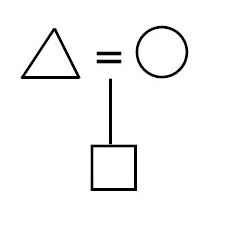
There were seven homesteads of this type in Kapsuswek in 1966, five of which were the only homesteads of monogamously married men.
By 1972 one of these had not changed, except for the birth of three more children (bringing the total to eight). Another, the case of the couple with only one child, mentioned above, had not changed except for the departure of two young male relatives (the husband's sister's sons) and their replacement with a third boy (agnatically related to the husband). Another of these homesteads was temporarily abandoned in 1972 when the wife and her children went back to her brother's home in another community after a long series of outrageous acts by her husband. At the time of the second census in 1972 he was drifting among the few age-mates he could still rely on for support while rumor had it that the breach was irreconcilable.
In contrast to this failure, another man with two young sons and four daughters in 1972 had recently married the eldest two daughters to men in Itembe and had bought a second farm four miles away with the intention of eventually marrying a second wife. The head of the fifth household had taken a second wife in 1971, the daughter of a close friend and neighbor, and had settled her on the same plot as his first wife (thus starting the development of a polygynous homestead, discussed more fully below).
The other two single household homesteads both belonged to polygynists, one a middle-aged man who regularly resides in Kapsuswek and periodically visits his second wife on a resettlement scheme, the other an elder who lives some distance away with his first wife and almost never visits his second wife living on a farm next to his brother's in Kapsuswek. Thus this homestead group effectively consists of a woman and her unmarried and uninitiated children.
Immature Extended Group
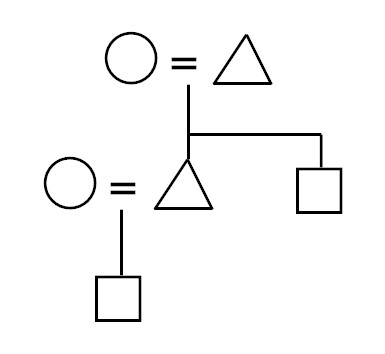
Four homesteads were in this stage of development in 1966, two of them with slight variations from the above diagram. In one, the nominal head, a former subchief with four other wives, rarely visited Kapsuswek. In the other case the group also included the homestead head's mother-in-law.35
By 1972 all four of these groups had undergone further development although only one of them had completed the transition to the next stage.
Mature Extended Group
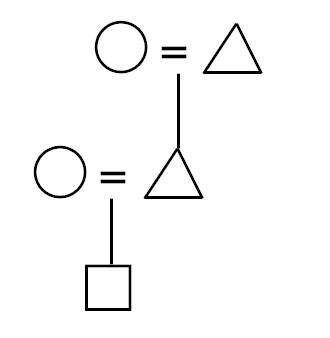
The one homestead to avoid the possibility of having to subdivide the family plot originally contained only two sons. More significantly, it was the only homestead of its type to belong to a polygynous elder with other land holdings. In 1971 the younger son, sixteen years old and just a year past initiation, married a bride from Kapsuswek and immediately moved to one of his father's plots a few miles away.
The other three families have not been so fortunate. In each case the elder is monogamous and owns no other land. And in each case a second son married during the interval between the census dates and brought his wife to the homestead while his elder brother's household is still resident there as well. These cases can be diagrammed as follows:
Immature Extended Group (Variant)
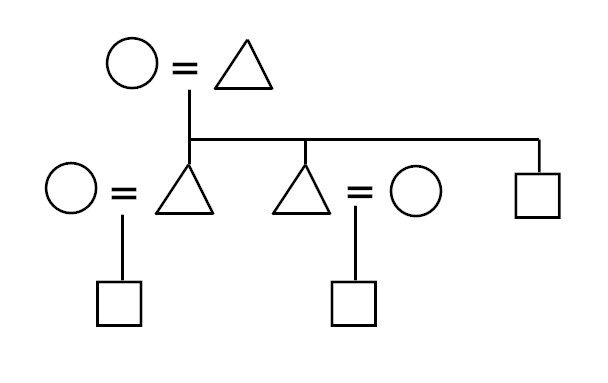
In each of these three cases two or three younger brothers are yet to marry. In two cases the eldest brother has turned to migrant labor. One is the young man who has taken his wife and children to Nairobi. He will probably be able to purchase his own plot eventually with his savings. For his younger brothers, and for the young men in the other two families, the goal of independent residence remains. But as land becomes increasingly scarce with rapid population growth, there is a very real chance that what is now considered a temporary situation of co-residence may necessarily lead in the future to the subdivision of the parental homestead.36
The future of these families can perhaps be seen on another farm which belonged to an elder in his early sixties. He had one wife and five children. The first-born, a son, had been fortunate enough to receive a plot in a land resettlement scheme in the early 1960s. His two sisters were both married to men living outside Itembe. His two younger brothers, however, both lived with their parents in Kapsuswek. The older had married just after moving to Kapsuswek in 1956 and had built a house for his wife about thirty yards from his mother's house. The younger son married in 1963 and built his house at the farthest corner of the plot, over a hundred yards away. These two men maintained different circles of friends and were rarely seen together. Their father died in 1969. By 1972 the older brother had six surviving children (the first-born, a boy, was killed accidentally in 1968 at age eleven) and was living at home with his family. The younger brother, who then had three small children, had taken a job on the tea estates near Kericho and visited his family at home once a month. Although their father's herd had been slightly larger than the average he was not a wealthy man and the younger son's wages were clearly insufficient for him to purchase another farm. It would appear that the location of the two brothers' houses was done in anticipation of subdividing the family plot.
Subdivision has already occurred on another homestead in the community which was originally settled by two brothers. Although this is a departure from the usual pattern, and thus does not fit neatly into the developmental cycle under discussion, the dynamics of this homestead group suggest the problems other families will face if more than one heir claims the same farm. Kiptele and Kipkoech arap Sang' were born in a community in the hill zone a few miles above Itembe. Their father died when the younger, Kipkoech, was an infant. Subsequently their mother had a third son, but when enclosure occurred in her community she was unable to claim more than a few acres. By the time Itembe was being surveyed for controlled settlement, Kiptele had a wife and one child. They had homesteaded in Itembe when it was still open land, and Kiptele had returned to wage labor on a European estate in the Rift Valley. He was not given a plot in Itembe when it was settled under colonial control although a plot was assigned to his brother who was then a bachelor serving in the armed forces. When the time came for registering for the plot Kipkoech could not get a leave pass and their mother summoned Kiptele from his job. He came and registered, using his brother's name. Since then both men have left employment and settled on this plot to raise their families. Although their two wives are close friends, assisting each other in child care and gardening, and often walk together to the markets a few miles away, their husbands continued to disagree over the ownership of the land. In 1967 the two brothers finally agreed on a division which gave the older one, Kiptele, about eleven and a half acres out of the original thirty. In July, 1970, Kipkoech sold nearly ten acres of his share (at K. Shs. 500 per acre) to Arap Rono, his wife's brother, a young man with one wife and three children, who had been living just outside Itembe. Arap Rono moved his family onto this small plot while Kipkoech took the money to purchase a piece of land in the forest near Molo, east of Kericho. He spent the next several months clearing the land while his family remained in Kapsuswek. Eventually he intends to dispose of the last fragment of the original plot in Kapsuswek and move them to the new farm he has pioneered. His elder brother, Kiptele, will probably remain in Kapsuswek (his first daughter married a close neighbor in April, 1972). By June 1972 he still had not built a new house on his share of the original plot, and although the boundaries were clearly marked, he had not fenced his piece nor separated his cattle from his brother's. With three young sons, a parcel of land that is scarcely sufficient at present, and a distinct lack of enterprise, his future looks far from promising.
It is highly unlikely that an old man will outlive his wife or wives (because of their differences in age at marriage, and perhaps because of a longer life expectancy for women). After an old man's death his widow will continue to live with the son who has remained in the parental homestead (or perhaps move to live with another son if she did not share her husband's choice of a favorite) and the result will be another typical type of homestead group consisting of a widowed grandmother, a middle-aged son and his wife, and their children:
Terminal Extended Group
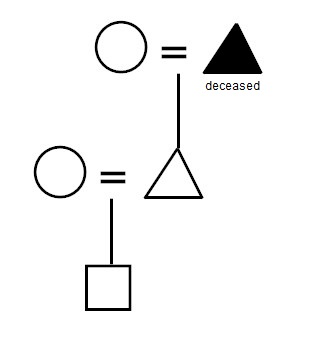
Three of the homesteads in Kapsuswek were of this type in 1966. One of them remained unchanged in 1972. With the eventual death of the old widow, the homestead group will return to the configuration of Stage 1, completing the developmental cycle.
By 1972 the other two homestead heads had enlarged their families by second marriages.
Needless to say, even if both wives enjoy equal reproductive success, striking an emotional and economic balance with two women of different ages, and two households at different points in their growth, is easier said than done. The potential for conflict is greatly reduced if co-wives live in different communities. If a man has the resources needed to establish a bride on a new homestead, he is free to do so at any point. But while I am not aware of any explicit norm to cover the other possibility, bringing a new wife into an existing homestead group, it would appear from the evidence in Kapsuswek, albeit sparse, that this choice is possible only when the existing homestead group is in an early stage of its development, and even then the move is often problematic.
During the census interval three men in Kapsuswek took second wives. One of these, mentioned earlier, had been living in a single household homestead with his wife and her six children (as it happens, all sons). The other two men were living in terminal extended homesteads, i.e. their widowed mothers were present as well as their first wives and their children. In one case the old woman had been widowed less than a year earlier. Her husband had been an extremely forceful and outspoken patriarch and her son, then aged forty-five, seemed driven to marry again as much by his first, rather late, taste of independence as by his share of his father's wealth. However, rather than build his seventeen year old bride a separate house, he put her together with his mother who was then in her eighties. The old woman complained frequently about having her household disrupted and started spending more time with her eldest son a few miles away. By 1972 the young wife had a child and was firmly established in the house while the old woman, when still on the homestead, slept with the first wife and her younger children. 37
The third man to take a second wife between 1966 and 1972 also lived with his widowed mother, his wife, and her younger children (her two oldest daughters were married, one to a neighbor in Kapsuswek). The man's second marriage took place in May, 1972, but less than a month later the bride, the daughter of a neighbor, ran away. She was seventeen years old, her husband forty—five. The marriage cattle had been agreed upon but not yet transferred, and it was unclear when I left shortly afterward if the marriage would be annulled.
A review of the census data suggests that however difficult it may be to establish a second wife on a homestead already occupied by a first wife with young children (Stage 1) or a first wife with young children and a widowed mother (Stage 4), it is virtually out of the question at other points in the developmental cycle. Although the number of cases is small I do not think it is an accident that there are no examples of a man bringing a bride into a homestead group already containing an initiated son, much less a married son and daughter-in-law. Similarly there are no cases of a married son, who lives with his father, bringing a second wife onto the homestead (although one young man with two wives lived on the farm adjacent to his father's). A case from Kapsuswek is illustrative. It involves an elder living with his (only) wife and their four sons. The younger two were still boys; the older two were married and have brought their wives to the family farm. By 1972 the older son had three children, the wife of the second son was in her first pregnancy. When the eldest son announced his desire to marry a second wife (who would quite clearly be coresident with his other household as well as his parents and brothers, his father flatly opposed the idea, commenting tersely that it would only lead to "conflict" (biret ap ge, literally beating each other ).
While there may well be cases, beyond my small sample of Kapsuswek, of sons taking second wives while still living with their fathers, such a situation clearly complicates the questions of authority and competition that can easily arise in extended homestead groups. No doubt the most compelling reason, these days, for avoiding this situation is the lack of sufficient land.
The problem of homestead fission, of seeing that each son ends up with his own homestead, is doubly difficult in cases of co-resident polygyny. Of five homesteads involving co-resident polygyny in 1966, only one had not yet faced this problem in 1972, and that only because the homestead head was unusually young for a polygynist. In 1966 his homestead group, as well as two of the others involving polygyny, contained only two generations, and might be termed simple polygynous homestead groups, diagrammed as follows:
Simple Polygynous Group
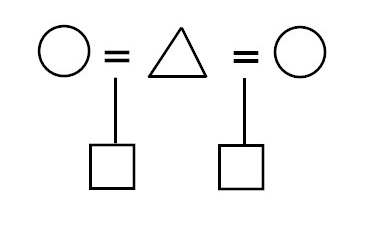
Immature Extended Polygynous Group
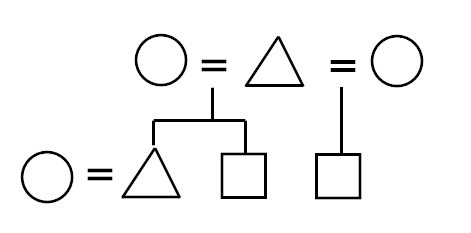
As Figure 2-10 indicates, the critical points in the developmental cycles occur (1) in maturing co-resident polygynous homestead groups, in which the homestead head should provide each wife with a separate homestead before sons have matured in both houses, and (2) in maturing 'monogamous' homestead groups in which all but one son should leave to establish independent homesteads of their own. Failure to do so in either case imp1ies the eventual subdivision of the original homestead land.
Ideal Development Cycles of Homestead Groups
'Monogamous: Homesteads Co-resident Polygynous Homesteads
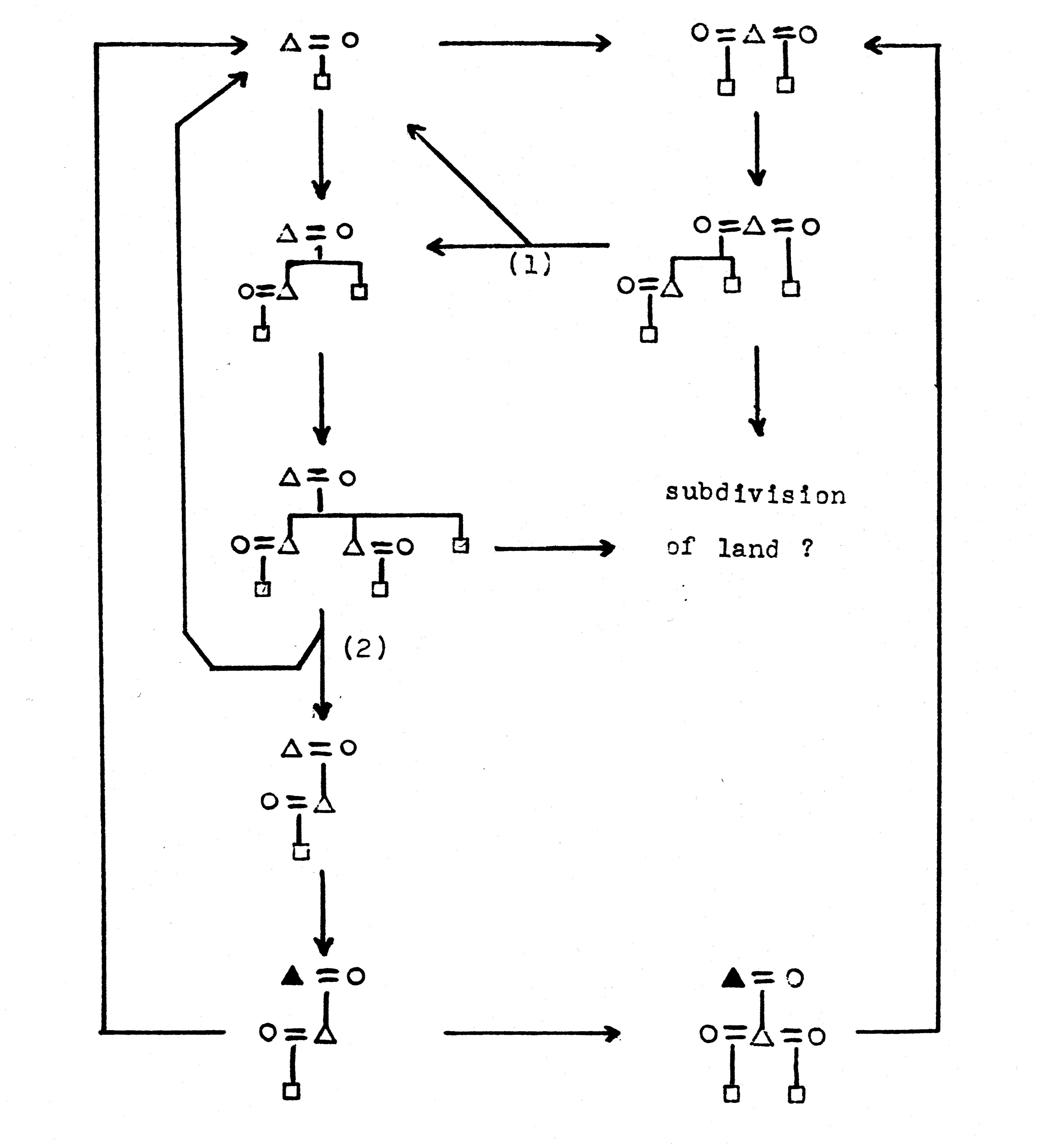
(2) All but one son establish independent homesteads
There are three homestead groups in Kapsuswek whose structures have departed from the regular developmental cycles. Two of these involve woman marriage, while the third involves violence and deviant behavior. In order to understand their organization, the history of these families must be considered in some detail.
Arap Chesimet was born around 1898 and is a member of Nyongi age-set. He served two years in the King's African Rifles in the World War I British campaign against the Germans in Tanganyika. On his return, he worked for several years as a foreman on European estates near Itembe. This income allowed him to buy cattle and marry his first wife, Tapkigen. She lives in Kapsuswek. She has had seven children: four daughters, now all married (two of them to men in Kapsuswek), and three sons. Tragically, the eldest boy was struck by lightning and died at age 12, the next boy died at age 10, and the third died as an infant. Her final pregnancy ended in a miscarriage.
Arap Chesimet's First Household
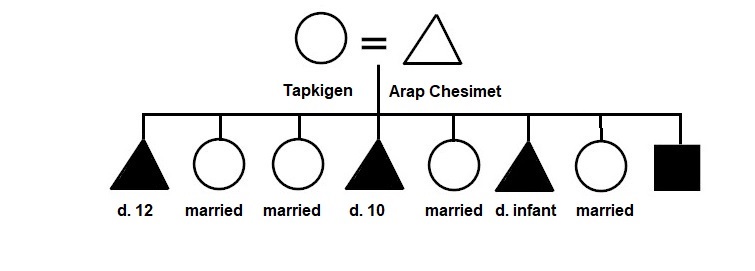
Arap Chesimet's Second Household
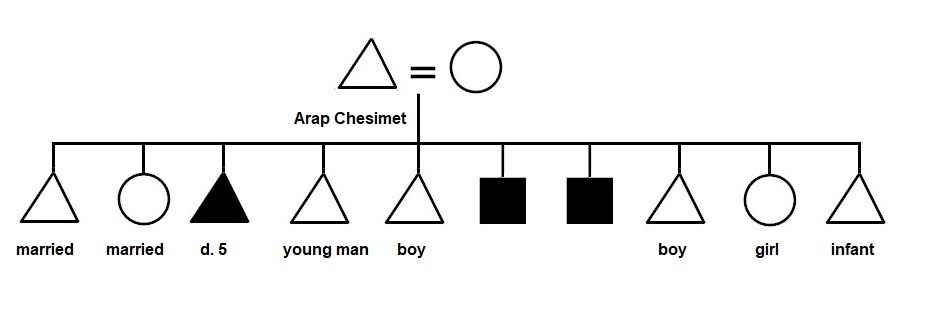
By 1972 Tapnyobi had had six children, all of them daughters, one of whom died before weaning.
Arap Chesimet's Wife's First Woman Marriage
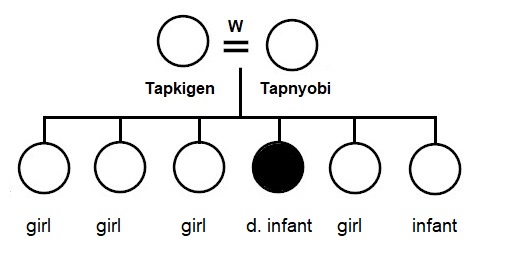
Arap Chesimet then arranged for an extraordinary second 'woman marriage' nominally involving Tapkigen. Inasmuch as paternity is established through marriage, the only way for a Kipsigis to adopt a Kipsigis child is to marry that child's mother. Somehow Arap Chesimet found a family willing to divorce one of their wives, Tapletgoi, a widow, who had two little boys and two girls. I can only speculate about the circumstances that would cause a family to give up male heirs (poverty? domestic violence? accusations of witchcraft?). Of course Arap Chesimet could not marry this woman, himself, as that would create a third house and only compound his problem. From his perspective the marriage between Tapkigen and Tapletgoi was clearly a formal arrangement to acquire an heir.
There was a divorce between Tapletgoi's husband's family and some representative of her natal family, most likely financed quietly by Arap Chesimet. Publically such arrangements have to go through the woman's father or his proxy; a second husband cannot acquire marriage rights to a woman directly from the family of her first husband. Tapletgoi's divorce allowed her remarriage.
Tapletgoi continued to live just across the southern border of the district in Maasailand, Narok District (where Kipsigis had been expanding without authorization for many years). Since the elderly Tapkigen lives more than 20 miles away, I do not know if she has ever met her second 'wife'. Quite possibly someone else stood in for the 'stand in husband' in a brief declaration of the marriage. Still things have not gone well. Since Arap Chesimet acquired (indirect) paternity of Tapletgoi's children, her younger son died at age 2, and her next child was another daughter.
Arap Chesimet's Wife's Second Woman Marriage
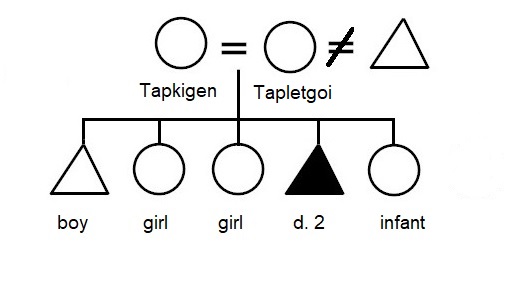
Though Arap Chesimet explained all this to me in a matter of fact manner, he must have surely wondered, in his private moments, why this loss of one son after another has been inflicted on him.
Putting the whole situation together makes it clear that the family crisis is far from over. To keep calculations simple, let us make a few assumptions:
- there will be no further births or deaths in the family (of course there will be)
- after his first two marriages, Arap Chesimet had built his estate of tug'ap boiyot to, say, 60 head of cattle
- he transferred ten head of cattle, out of Tapkigen's household account, for each of the woman marriages involving her (marked in yellow)
- he has received, or will receive, 10 head of cattle for each of his daughter's and granddaughters' marriages (marked in green). These tug'ap koito belong to their respective houses
Arap Chesimet's Larger Problem
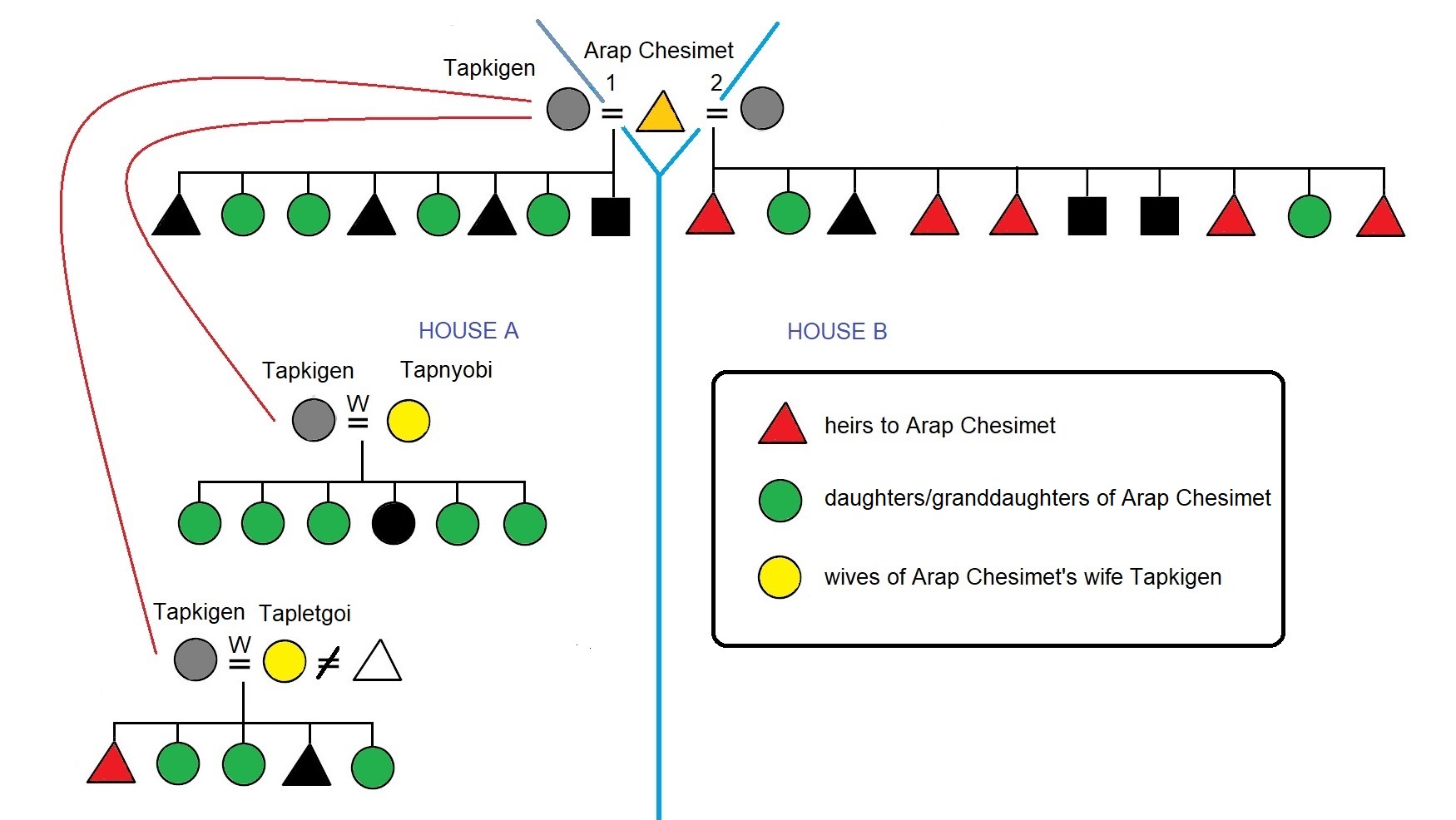
Ideally, the final settlement of accounts would work out as follows:
| House A | House B | |
|---|---|---|
| tug'ap boiyot | 30 | 30 |
| tug'ap koito given | -20 | 0 |
| tug'ap koito received | 120 | 20 |
| Totals | 130 | 50 |
| Amount for each heir | 130 | 10 |
Many years in the future, undoubtedly after Arap Chesimet has passed away, if everyone fulfills his moral duty, the senior men in the second house will be expected to settle accounts with a young man who will announce himself as their (half-)brother and claim as his inheritance the vast majority of the family cattle which they have been tending for years.
In the second case involving kotunji toloch all of the people concerned live on the farm in Kapsuswek and the homestead group is thus rather complex. Arap Sitonik, born in 1908 and a member of Maina age—set, has two wives who both live with him. By 1972 the younger wife had three boys and two girls, the oldest born in 1961 and the youngest in 1970. Arap Sitoik's first wife, Tapsabei, had six children, including a boy and a girl who died in infancy. The four surviving children are all daughters, now married women (one married to a man in Kapsuswek). Tapsabei has married two young women (her first wife is one of the daughters of Arap Chesimet and Tapkigen mentioned above). This young woman, Tabelga, has three sons, born in 1962, 1965, and 1971 (a daughter born in 1967 died of accidental injuries when a year and a half old). In 1966 Tapsabei married a second young woman from another family in Kapsuswek. By 1972 this woman had still not had a child; nonetheless she has remained a member of Arap Sitonik's homestead group rather than being sent back to her parents. The homestead group can thus be diagrammed as follows:
A Homestead Group Involving Woman Marriage
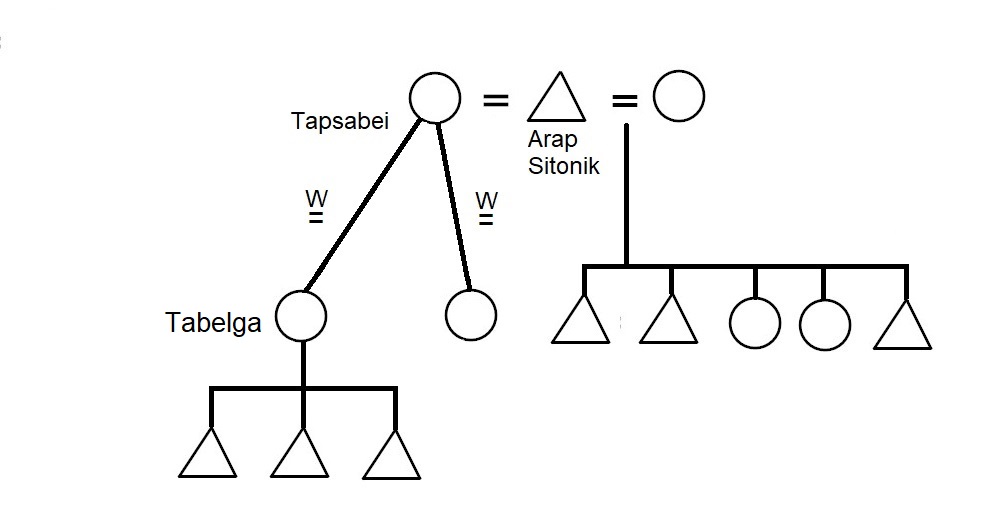
The third homestead group in the community to deviate from the usual course of development is unusual in several ways. As of 1972 the homestead group can be diagrammed as follows:
An Atypical Homestead Group (1972)
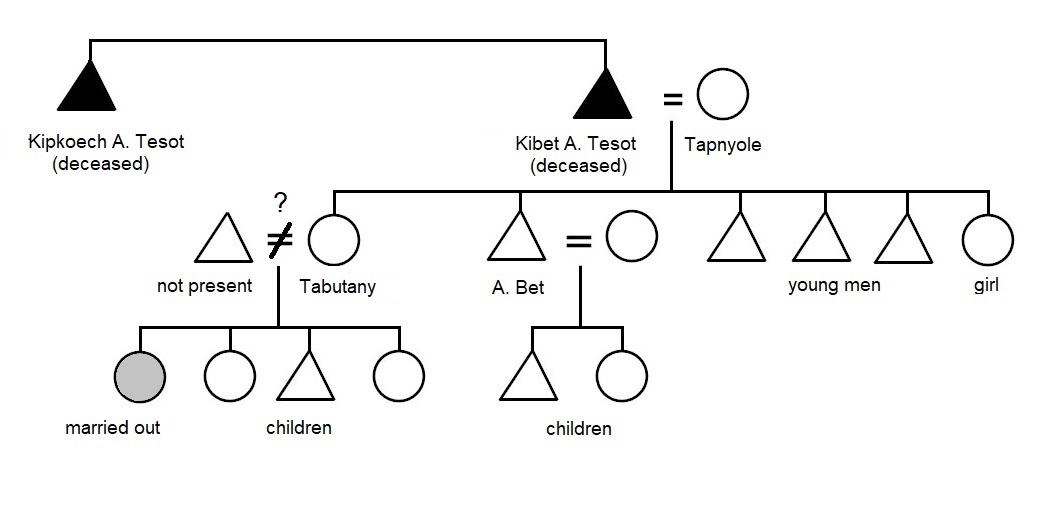
In 1966 Kipkoech arap Tesot was an old man living by himself on a separate section of the farm (this plot is divided by a stream). His natal family had been very poor and he had worked for many years on European dairy farms in the Rift Valley. He married once and his wife had one child, a girl. While very young the child died accidentally. Shortly after that his wife fell ill and died (he claims she was bewitched by Luo workers on the estate where they were living). When his brother was allotted a place in Itembe in 1956 he came to live with him.
Kibet arap Tesot, the original owner of the plot, was murdered by his wife, Tapnyole, in 1962. The neighbors report that the marriage had long been marked by fights and periods of desertion and adultery by Tapnyole. Immediately after killing her husband in her house in Kapsuswek, Tapnyole surrendered herself to the police in Bomet. Although the account given to me by neighbors made it clear that the murder was premeditated, the police could only prove manslaughter. She was sentenced to one year imprisonment in Kericho, and released before serving her full sentence. Neighbors explained that she was given a light sentence because her youngest child was then only about a year old, still nursing, and thus in prison with her.
Tabutany, one of Tapnyole's four married daughters, was sent back to her mother's house by her husband shortly after the murder. He claimed to have found her keeping witchcraft substances in her house; no doubt he was influenced by his mother-in-law's crime. He demanded a divorce, and subsequently Tabutany has as well, but by 1972 the family had still not been able to return the marriage cattle and thus formalize the end of the marriage. Tabutany's two younger children were born in Kapsuswek after her separation from her husband.
When Tapnyole was released from prison she was attacked by her brother-in-law and her eldest son. She was severely beaten and required hospitalization which in turn led to a court case against the two men. Later her brother-in-law instituted a case against her, claiming that she had collected his cattle from a kimanagan loan partner of his and had sold them without his permission. Neighbors told me that he lost the case in the local court, unjustly, because he was too feeble to argue coherently. Tapnyole then threatened his life, and he took to wearing a sword under his coat and carrying a panga (machete) although he did not really have the strength to defend himself. Since then Tapnyole resumed her habit of disappearing from the community for months on end. Her neighbors professed no knowledge of where she "wandered."
During the dry season of 1966-1967 the short rains failed, and Kipkoech arap Tesot watched helplessly as the last of his cattle died. when I last saw him in l968 he was living off the grudging charity of his neighbors and what little he could gain through trading corn for honey with relatives among the Okiek in the forest when he had the strength to make the trip. He died in abject poverty in 1971, leaving behind no wife, no children, and no cattle. As the Kipsigis say, he was a man whose fire had died.
When I interviewed Tapnyole in 1966 for my census, I found her to be a pleasant old lady who demurely, almost coyly, answered all of my questions while we delicately skirted around those topics I had been forewarned by neighbors to avoid. When I asked a neighbor what his assessment of her was, he replied "Ma kararen metit", Her head is not right, and left his darker suspicions unsaid.
Fortunately it appears that the younger generations of this family will outgrow the past. Tapnyole's eldest son, Arap Bet, married in 1966 and by 1972 had two children. He and two of his younger brothers have taken jobs in the tea estates while their sister's eldest daughter was married in 1970 into a respectable family in the next community, a family that is also related by marriage to two other homesteads in Kapsusuwek.
Although most Kipsigis believe that retribution for the sins of anestors may continue to be exacted upon succeeding generations, the young people in this family are well received personally and, most importantly, are being reintegrated into the social fabric of their neighborhood.
(a) an old man and two of his deceased half-brother's sons living on three non-contiguous farms, (b) a pair of full brothers, one of whom was absent, living on adjoining farms, (c) a pair of half-brothers (the younger raised by the elder's mother when his own mother died immediately after his birth) living on two adjoining farms, and (d) a pair of half-brothers living on farms diagonally opposite each other across the main road.
The other seventeen homestead groups were independent family units within the context of the community. Thus twenty-one families, or kapchi in an immediate sense, were represented in the community.
There are also three ties of common clan (oret) membership, each between two local family groups (in one case involving a local family cluster), in which common descent could not be traced. Thus eighteen clans (ortinwek), or exogamous descent categories, were represented among the men in the community.
While the members of neighboring homesteads relate to one another in several different ways, according to different criteria at different times, kinship provides by far the most pervasive order to their interactions. A community, when it acts as such, is literally a community of interest. Just as an individual's interests within the family are shaped by his or her position in its structure of households and sets of siblings, so a person's interests in community affairs are delineated by their standing in the network of kinship which ties their lives together according to a series of clearly defined relationships.
A critical feature of Kalenjin kinship is that siblings of the same sex are equated with one another in tracing both cognatic and affinal ties to others. Similarly, co-wives, and thus their sets of children (half siblings), however much they are placed in positions of rivalry within the family, are identified as one in wider relations. Thus a man refers to, and addresses, his brother's mother-in-law or his half brother's mother-in-law as his mother-in-law, just as he calls his mother's co-wife's brother "mother's brother." In an example from Kapsuswek involving two local family clusters it is clear how this extension of terms along agnatic lines is congruent with the concept of marriage as being a link between two family groups:
An Example of Extended Affinal Ties
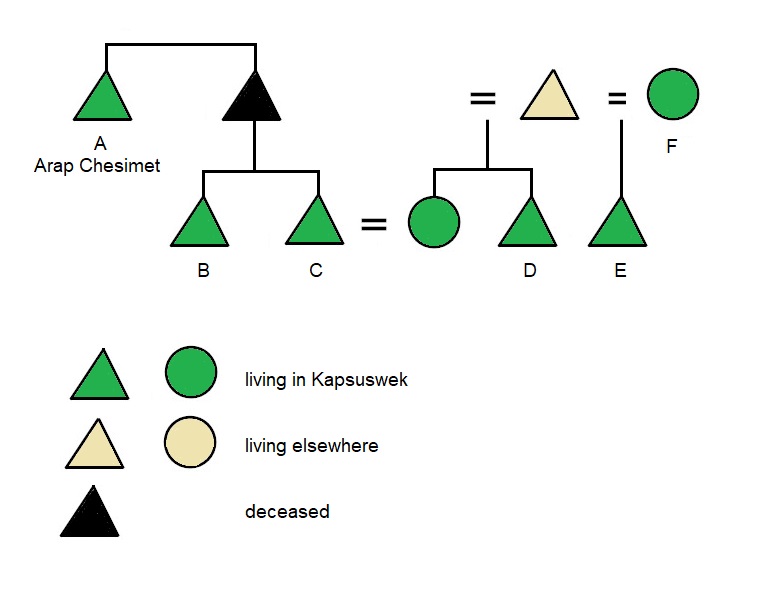
Kalenjin also contains a pair of terms to express the relationship between the parents of the bride and the parents of the groom: batiem, used between the two mothers and between the father of one and the mother of the other, and bomori, used between the two fathers. These terms are also extended in a manner similar to that of the other affinal terms. Thus among the people shown in Figure 11, A and F address each other as batiem.
It follows that in addition to what might be termed a direct marriage tie created between the homestead groups of a man and a woman who are both members of the community before marriage, there will also be a number of indirect marriage ties linking pairs of homesteads in the community through marriages involving relatives of each homestead who live outside the community. It should be stressed that the distinction being made here between direct and indirect ties is one I have introduced for analytical purposes; the distinction is not made in the everyday use of kin terms, or the modes of behavior appropriate to those terms, by the people of the community.
Indirect affinal ties, when traced genealogically, can be of various degrees of complexity, as a few examples from Kapsuswek will show:
- Arap Mutai calls Arap Lang'at sandaniin because Arap Lang'at's brother, who lives in the next community, married Arap Mutai's half sister.
- Arap Bii calls Arap Mosonik kapyugoi because Arap Bii's second wife is Arap Mosonik's father's half brother's daughter.
- Arap Bii calls Arap Ng'eno kapyugoi because Arap Bii's first wife is Arap Ng'eno's father's father's half brother's daughter.
An Example of Indirect Affinal Ties
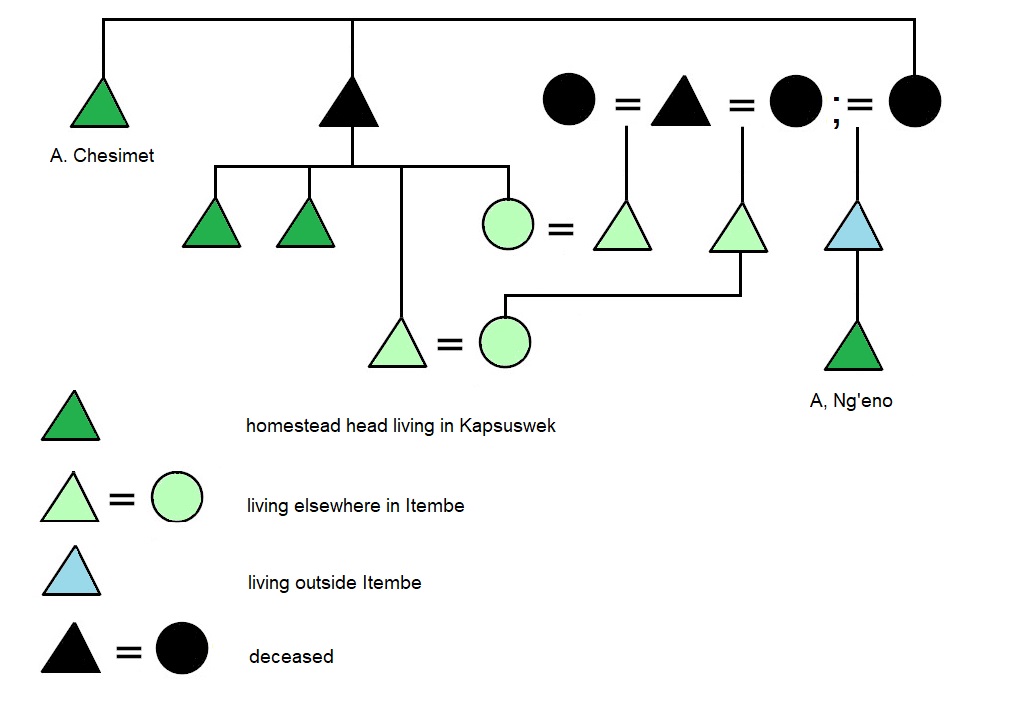
As with the other affinal ties, the lemenye relationship can be extended; a man is not only lemenye to his wife's sister's husband (WiSiHu), but also to his brother's WiSiHu, his half brother's WiSiHu, his father's brother's son's WiSiHu, etc. This extension can take place at either end of the relationship, so that a man is also lemenye to his brother's WiSiHu's brother, half brother, father's brother's son, and so forth. Similarly the term can be expanded for the broader meaning of the term "sisters" (agnatically related), so that two men are lemenye if one's wife is the other's wife's half sister, father's brother's daughter, etc. As in all extensions of affinal ties, the extent of the recognized relationship is not limited by formal rules but by the geographic, and hence social, proximity of the people involved. In other words, a genealogically distant relationship to another member of the community may have more behavioral meaning than a close genealogical relationship to someone miles away with whom one has little or no contact.
In even more general terms, the lemenye relationship exists, or more exactly can be recognized to exist, between any two men from two different kapchi if both kapchi contain a man who has married a woman from the same third kapchi. This definition holds for whatever level of reference is intended for the term kapchi. The following example illustrates three such lemenye relationships between various members of two families represented in Kapsuswek:
An Example of Lemenye Ties
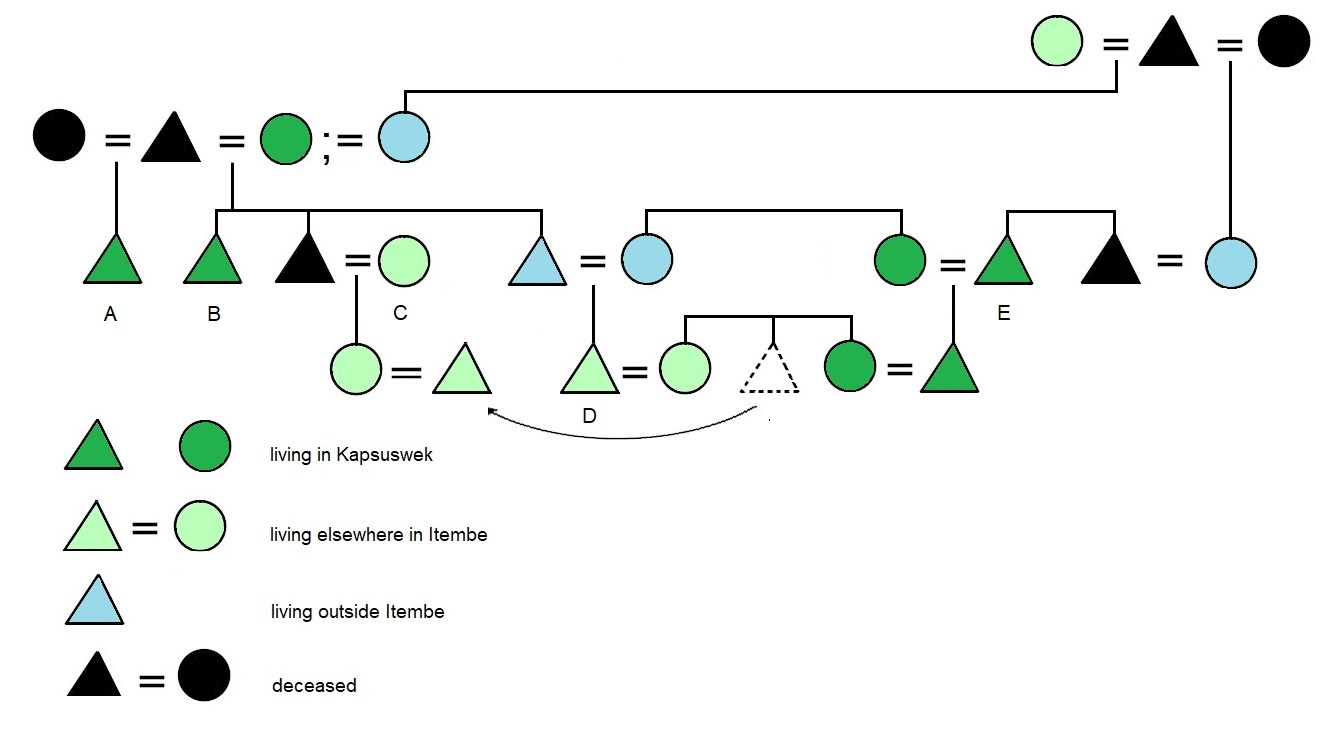
While the relationship between brothers-in-law is considered asymmetrical, with the sister's husband (sandaniin) indebted to the wife's brother and his agnates (kapyugoi), the relationship between lemenye is reciprocal and is marked by a sense of relaxed fellowship. In one sense this is because lemenye are husbands of sisters whose relationship is marked by affection and cooperation free from the competitive undercurrents of property considerations. More directly, the lemenye relationship is the only one in which the two partners have not engaged each other in a cattle transaction. Rather, as one man explained to me, "lemenye are allies because they have both struggled to satisfy the same old man's demands for marriage cattle."
Figure 2-20 shows the kinship connections between the twenty-one family groups (another, Arap Rono's, joined the community in 1970). Arrows indicate the direction taken by brides in the marriages between these families. For direct marriages, dark green arrows literally show the movement from one homestead to another in Kapsuswek. For indirect marriage ties, pale green arrows indicate that a marriage has occurred outside Kapsuswek in which a bride related to one family in Kapsuswek has been married to a man related to another family in Kapsuswek.
Seven families had been previous residents of Itembe when it was open land. They tended, in 1958, to have more connections with their neighbors than those people who came from outside Itembe (the exception to this, Arap Birir, is marginal to Kapsuswek; presumably most of his connections are with neighbors in the adjoining community). No doubt some of the connections with existed in 1958 simply represent a "background level" of ties which one might expect in any chance sample of families which come together from a wider part of a densely interrelated society. Yet a closer look at the spatial and temporal ordering of several of these connections is revealing.
Relationships Among Families in Kapsuswek
at Completion of Settlement, June 1958
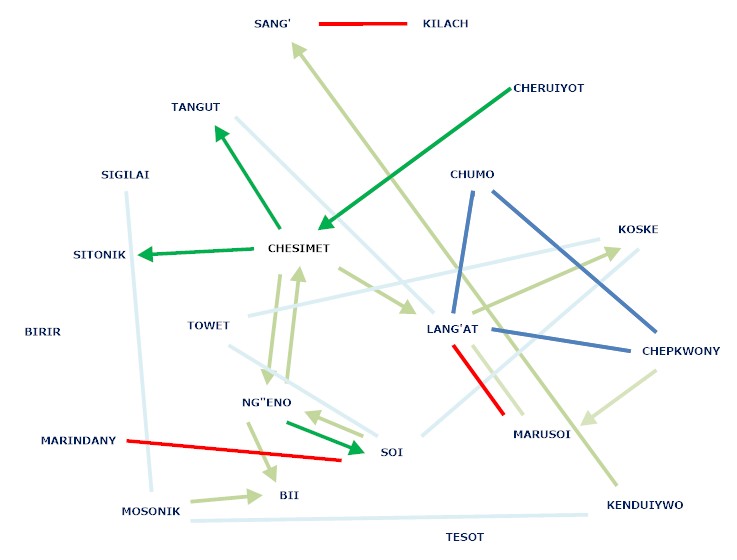

The settlement of Itembe by the colonial government was motivated, in part, by a desire to regulate, in one small area where the government could exercise direct control, a process of homesteading and enclosure which was going on throughout the open areas of Sot Division as the population rapidly expanded. While the British were concerned with creating an orderly, and egalitarian, parceling of the land, they left those chosen as settlers wide latitude in the choice of individual plots. In terms of community organization, the resulting settlement pattern is not felt by the inhabitants to have deviated from patterns being followed more generally over extensive areas which were not regulated. In several cases in Kapsuswek, incoming settlers chose plots in order to be near relatives already in place. For example, Arap Lang'at and his father (an old man who died a few years later) settled next to Lang'at's wife's sister and her husband, Arap Chepkwony. A year later, Arap Chumo, whose first wife is the third sister from the same family, heard through these people of the chance to settle in Kapsuswek as well. Thus adjacent farms were settled by three extended families contained married women who are full sisters, i.e. the men in these families are each other's lemenye. Similarly, Arap Ng'eno chose to settle next to his sister and her husband, Arap Soi's son. In another example, Arap Tangut heard of the opportunity to acquire a plot next to his father-in-law when the man originally assigned to it, who was unrelated to either of them, failed to satisfy the settlement authority.
Kipsigis residence rules are coded in Murdock's Ethnographic Atlas as "patrilocal."40 If one is working only from normative descriptions given by key informants this is perhaps not an unreasonable surmise since the one rule that is easily stated is that one son should remain on his natal homestead. I have discussed the inadequacies of this classification system elsewhere in detail.41 A quick review of the data here will reveal the problem:
- the genealogies of Kapsuswek families and their relatives include 58 sets of brothers containing 188 men, or 58 who should live at the parental homestead and 130 (69%) who would be expected to move elsewhere if land were available
- Generalizing from my genealogical data it appears that between 30 and 45% of all married women have co-wives who live in other communities. In such cases one son of each wife will remain at his natal homestead. Is each son living patrilocally if, at best, his father is alive and present part-time?
- In my interview sample of 58 men, a third did not have surviving fathers at the time of their initiations
- if the son lives on the parental homestead but his father is dead, is he living patrilocally or should we, perhaps, say that his widowed mother has chosen to continue residing 'filiolocally'? What happens when she chooses to move to another son's homestead?
- how are we to classify the residence choices of grown son's from kotunji toloch and "daughter adoption" marriages, whose paters are female?
Nor is any descriptive purpose served by sweeping the majority of cases into a box labeled "neolocal." It is true that men seeking land are quite willing to settle in communities where they have no previous kin ties (though through extension of ties made by considering an individual's kapchi on the general level of oret it is almost certain that a man can find some people to recognize with affinal terms in any community). The majority of men choose to settle near, or perhaps more accurately develop the opportunity to settle through, relatives outside their immediate agnatic kapchi. Inconveniently for our usual classifications, but quite logically to them, this category includes kinsmen to whom they have no direct connection, a variety of affines and cognates (wife's father or brother, sister's husband, wife's sister's husband, mother's brother, etc.), or even in some cases, no doubt, "pseudo-kin" such as initiation mates or initiation sponsors. Clearly it profits a man and his sons to develop and maintain a variety of relations to many people in many places in order to maximize options in the face of pressures for homestead group fission and dispersal in each generation. When the pattern of residential dispersal is combined with a strong tendency for local endogamy, as can be seen in the history of Kapksuswek, the terms "patrilineal" and "patrilocal" obscure, if not actually mislead our understanding of the resulting fabric of community organization.
If falling on love with the boy next door is an American cliché, the equivalent in Kipsigis is to arrange the marriage of one's daughter to the son of the elder next door (or perhaps to the elder himself, or to his aged wife if she has no sons). The first marriage between neighbors in Kapsuswek occurred shortly after settlement had been completed in 1958, and many more marriages have taken place between families in the community over the subsequent years, as seen in the comparison of Figures 2-20 and 2-21.
The chances of local intermarriage are very high, of course, in a newly settled community. When analyzing the data from this first research period, I supposed that the possibilities for community endogamy were rapidly being exhausted. But upon my return to Kapsuswek in 1971 and 1972 it immediately became obvious that this was a premature judgment. As the contrast between Figure 2‑21 and Figure 2‑22 shows, in the intervening four years there were eight more marriages between neighbors.42 One other marriage had occurred between mutual relatives outside the community as well. Together these new marriages created five new lemenye ties among men in the community. Clearly a high rate of local endogamy is a persistent feature of Kipsigis social organization; indeed it is the major process by which community structure evolves.
Relationships Among Families in Kapsuswek Relationships Among Families in Kapsuswek
at Completion of Settlement, June 1958 in February 1968

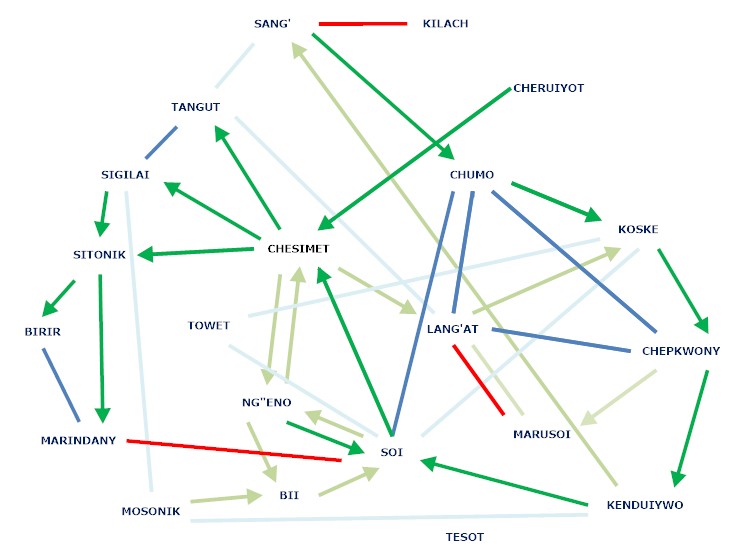

Relationships Among Families in Kapsuswek, June 1972
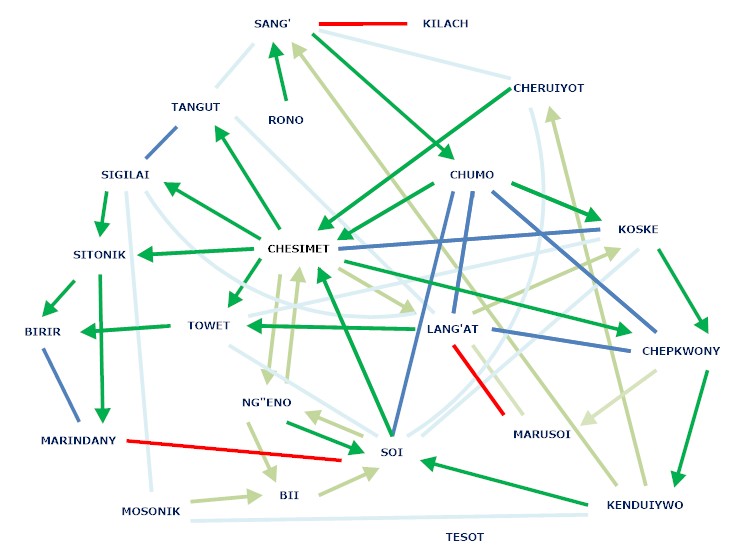
In all there have been forty-five marriages involving residents of Kapsuswek in the sixteen years between 1958 and 1972. Seventeen of these have been those just discussed in which both partners were community members. Thus slightly over a third of all marriages were within the community. Put another way, just over half of the brides married by people in Kapsuswek since settlement came from within the community, and just over half of their daughters' marriages were, similarly, to people among their immediate neighbors. As Table 2-13 indicates, the great majority of the other marriages have been between a person in Kapsuswek and someone from one of the other communities (kokwotinwek) in Itembe. Indeed, all of the marriages were between people no more than an hour's walk apart.
| Married out of Itembe 3 |
||
| Daughters of Kapsuswek Residents |
Married elsewhere in Itembe 10 |
|
| Married within Kapsuswek 17 |
||
| Married from elsewhere in Itembe 10 |
Brides of Kapsuswek Residents |
|
| Married from outside Itembe 5 |
Relationships Among Families in Kapsuswek June 1972 Agnatic Ties Among Senior Men in Kapsuswek

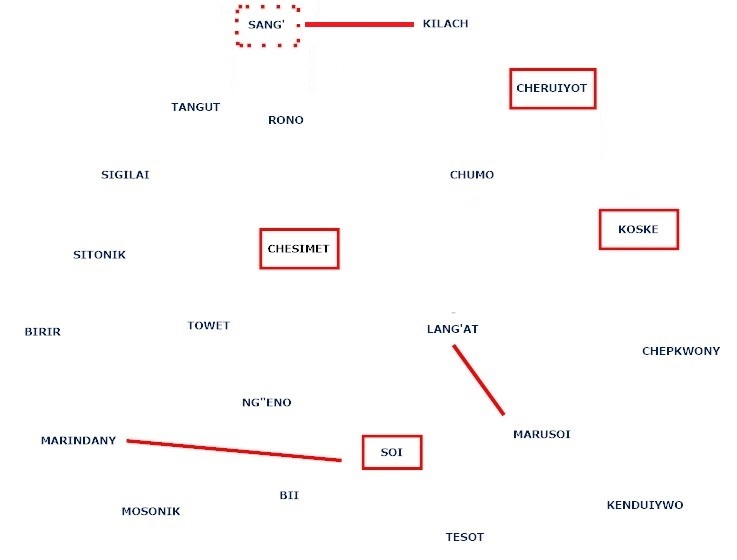

While men are surrounded, not by agnates but affines, and have a keen interest in networking both directly with their neighbors and by tracing connections through relatives living outside the primary community, the situation looks very different from the women's perspective.
Women's direct ties to mothers, sisters, and daughters
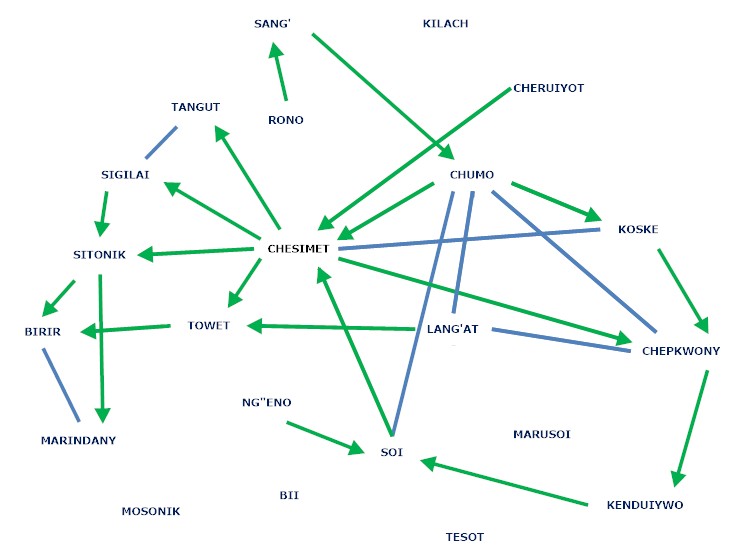
For women the homestead group into which they are married is composed of affines, while the network of direct marriage ties and direct lemenye ties within the comminuty, as shown in Figure 2‑24 indicates other homesteads in the community containing their fathers and/or brothers, and more importantly, their mothers, married sisters, or married daughters. Because sons disperse, and because men often establish homesteads in other communities where their wives' families are located, it would appear that in many communities, as in Kapsuswek, the density of the network of women who are immediate female consanguineals, one to the next, is far greater than the density of the network of male agnation, even when that is extended in a classificatory sense. There can be no doubt that this pattern, which is obscured by descriptive terms such a patrilineality and patrilocality, is highly significant in a society in which women interact most frequently with other women, form their own cooperative work groups and initiation groups, and must deal with husbands who themselves have been initiated into the pastoral virtues of overt male dominance.
As the localization of recent marriages implies, many families in the community are closely related to others around them, and all of the families in the community are, of course, related consanguineally and affinally to others, both near and far, in several directions. Where these relationships involving two families within Kapsuswek lead to mutual relatives elsewhere this condition has been indicated as an indirect tie. On the one hand, the community is a single localized network incorporating virtually all the people in the primary neighborhood. On the other hand, this network is only partially differentiated from a wider social fabric. This situation raises the issue of the nature of community boundaries.
As a geographical feature, the name of the community (Kapsuswek is a pseudonym) refers to a rise of land bounded in three directions by small creek beds. Topographical features obviously facilitate or inhibit patterns of interaction, no doubt more severely in the deeply folded hill areas than in Itembe, and it is common for communities (kokwotinwek) to be associated in an approximate way with areas of land bounded by streams or rivers. Here the creek beds clearly set off the core of the community network. Yet several homesteads which are in every behavioral sense part of Kapsuswek lie across these "boundaries" (specifically the homesteads labeled in Figures 14-16 as Birir, Sitonik, Marindany, Mosonik, Bii, Towet, and Kilach). In terms of people's interactions, local geographical features merely suggest, but in no precise way describe, the set of people who consider themselves members of the same kokwet.
All around the network of families that compose Kapsuswek are other, similarly organized communities. In some cases, such as Arap Birir's, a homestead which lies in the margins is tied to both local networks. But while almost all of the homestead groups in Kapsuswek are related to others in Itembe, along most of the edges of Kapsuswek these ties do not extend to immediately adjacent families as they do, with such complexity, within the community.
Yet while the community network is of one piece, and on most sides is fairly clearly differentiated from neighboring homesteads, the boundaries of a community do not necessarily contain a complete set of contiguous farms; the family living between the homesteads of Arap Sitonik, Arap Chesimet, and Arap Towet has not been shown in Figures 14-16 because it traces no connections to others in Kapsuswek. Throughout the entire period of fieldwork I never met the head of this homestead, whom I knew quite well from another context, taking part in any formal or informal social activities in the community. In contrast, the young men from Arap Tesot's homestead, while not directly related to their immediate neighbors (no doubt because of the family's unfortunate history), were constantly in the company of age-mates in the community. Put quite simply, there are no geographical boundaries as such in Kipsigis social organization, aside from those imposed and maintained in this century by outside institutions. Even the fences and hedges which now enclose individual farms, themselves a response to twentieth century changes (Manners 1967; Daniels 1980), scarcely limit the flow of foot traffic and interaction among the local population.
A community, as the Kipsigis usage of the word kokwet implies, is a group interaction. While not readily described in the usual anthropological terms, the situation is easily visualized by imagining that each homestead is like a neuron connected to several of its neighbors, and rather idiosyncratically to many other neurons scattered more distantly. There are several modes of connection: close agnation, common descent classification, a series of types of affinal ties (both symmetrical and asymmetrical), special relationships arising out of initiations, private cattle loan partnerships, and others. The day to day processing of material and information causes, in this neurological analogy, a constant "twinkling" as various homesteads are activated. In general the actions of one homestead will elicit actions by others, according to the nature of their connections, with discernible areas of locally increased and self-reinforcing activity. Various initial occurrences activate different patterns. Agricultural chores "light up" small knots of interrelated neighbors. Weddings activate two agnatic nets, and some immediate affines, spread quite widely. Annual initiations appear as fairly closely synchronized "firings" of groups of thirty or so "neuron-homesteads" all across the map. These clusters are centered slightly differently each year, and their activities last longer than most other events, but they do not reach every homestead in any given annual episode. Over time repeated incidents will appear to indicate the presence of localized clusters of twenty to fifty homesteads that act together. Their "firings" are never exactly the same pattern twice, the effects of their activation trail off in different directions at different times, and their edges interpenetrate.
Such is the nature of the Kipsigis community or kokwet. As a series of kokwet meetings are called in one area, a slightly different collection of men will gather at each. The fact that the same elders dominate discussion over and over is not due to any sense of a membership roll, or set of formal offices, but quite simply because they, being so complexly interrelated to the families around them, will be continually implicated in public events and will have a real interest in the outcome of group decisions.
Pushing the neurological analogy a bit further, one can see that each individual's choices of interaction are influenced by a series of different relationships with the others involved. Just as redundancy of wiring in a computational system can produce the same logical propositions consistently despite instability or unreliability in the behavior of individual components (McCulloch 1965), so Kipsigis communities maintain a sense of values, a sense of how their various lives interrelate and what is to be done when incidents or erratic behavior by one or another individual occur.
Kipsigis communities are thus not only communities of interest in the mundane matters of subsistence but in the deeper issues arising out of permanent interrelationships which create shared fate. The community is those who sit in judgment of each other's transgressions, those who gather to initiate children, bless a wedding, or ratify a divorce. In terms of daily life the community is the very dense localized knot of relationships whose multiple circuits govern individual behavior.
Kapsuswek is just one such community among hundreds tied together in a system of such resilience that in the 1970s it had managed to preserve the qualities of Kipsigis domestic life despite nearly eighty of change that have seen the elimination of the old tribal level of military defense, the introduction of a new staple crop and a major shift in the balance between pastoralism and agriculture, the introduction of new concepts of government, public order, religion, and education, the involvement of every household with the edges of the worldwide economy, and an unprecedented expansion of the population.
With the passing of the nineteenth century has gone much of the tribal world which gave overt meaning to the content of male initiations. And yet the structure of family life, the patterns of interactions between men and women and between adults and children, from which initiations derive a large part of their personal psychological import, has maintained a strong continuity with the past.
2 According to Murdock's terminology, the Kipsigis oret would be labelled a sib: "a maximal lineage with geographically dispersed membership, with few if any corporate characteristics, and with an unknown or merely postulated or traditional ancestor ..." (Murdock 1960:1). The use of the word clan for this type of unit follows that of most previous authors on the Kalenjin, and is the term the Kalenjin themselves use in English to refer to oret.
3 Many of the women in Kapsuswek claimed not to know either their father's or their husband's clan. Technically a woman retains the clan affiliation of her father after marriage, but in any case women are said, by men, to be only "attached" to clans.
4 The response does not depend upon the clan affiliation of the questioner, as has been reported for societies in which descent groups are in structural oppositions.
5 The four main borosiek were called Kipkaige, Ng'etunyo, Kasanet, and Kibeni. They were considered to be paired with major and minor parts, and with a series of subdivisions.
6 The Nandi term used by Huntingford, pororiet, is the equivalent of the Kipsigis boriet (cf. Evans-Pritchard 1940a:264). "p" and "b" are allophones of the same phoneme.
7 This point is supported by Manners (1967:248) and by my own data.
8 This was the battle of Ng'oino (Peristiany 1939:163). My data suggest that this battle occurred in the middle of the nineteenth century.
9 I found no evidence of a revival of boriosiek groupings around modern political issues as Manners (1967:248) suggests.
10 For example, Kiptilgarit (kip-, male prefix; til, cut, garit, car or wagon [from the Swahili "gari", ultimately from Hindi?]), was the name given to those initiated around 1901 when the railroad cut between the Nandi and the Kipsigis. Siling'isiek (shilling + -isiek, plural suffix) comes from the introduction of the East African shilling in 1922 in place of the earlier rupee, and Lesebet, 1952-53 marks the ascension to the throne of Elizabeth II. The name of the last sub-set of Sawe, Kibago, was reported by a few informants. Kibago refers to hoodlums, and marks the first appearance of incidents of minor holdups and harassments by bands of young men on the roads at night. It is considered very funny by some of the older men of Sawe age-set that the new initiates had this name pinned on them. In general it appears that most men no longer keep track of sub-set nicknames for recent age-sets.
11 The decision cannot be reversed, nor can a man once identified as being among the first or a new set "step up" and join the last of the preceding, senior, set.
12 With very rare exception, all non-Kipsigis in Kericho District live in such towns or in other non-indigenous settlements (labor estates, school and hospital compounds, etc.).
13 General discussions of acephalous societies have been concerned with the regulation of deviant behavior through informal mechanisms and have thus tended to emphasize a sense of homeostasis. I think it is also necessary to note that in communities organized such as the Kipsigis one described here, there may well be individuals who persistently violate social norms, and who, if they do not respond to informal social pressures or cause serious damage, simply have to be tolerated because they are closely tied to everyone else by kinship.
14 Space does not permit a discussion of that most elusive subject, precolonial patterns of political behavior. As I hope the analysis of local groups shows, there was no clear cut organization of geographically defined districts. THe traditional office of "chief," kirwogindet, (plural = kirwogik) was not so much a formal office as a public recognition of an elder who was considered by most as an "arbiter" of public opinion (the literal translation of kirwogindet). It follows that his "jurisdiction" was those people who respected his opinions, and that they would naturally tend to be the people of a certain area, but not one that can be considered hard and fast.
15 Harold K. Schneider argues that the definitions of rights to cattle in African societies play a central role in determining many aspects of the particular variant on a common African pattern which a given society represents (1964,1969).
16 The situation in Itembe shows the continuing importance of traditional attitudes associated with cattle quite strongly. In a brief study testing the relationship between the economic status of the family and perceptions of coin size among children (Munroe, Munroe, and Daniels 1967), the measure of family wealth that yielded significant results was a simple count of the number of cattle on the homestead, disregarading the quality of the cattle and the great variation in monetary wealth between those fathers of subjects who were regularly employed and those who were "sitting at home." It was the concensus of opinon in Itembe that the Maasai, with their large herds, had greater wealth than the Kikuyu, who were most heavily involved in the national (cash) economy.
16 The word "fire" (maat, maa) also is used to refer to clan or clansman. The most common curse is mein maa, "may your fire die." A man who has a male heir is said to "have fire."
17 The special care and attention needed to survive to a very old age cannot be automatically assumed. The very few men I knew who survived into their late 80s and 90s kept alive by maintaining direct personal control over significant amounts of property and they did this by constantly exercising their very strong personal characters in order to gain compliance from those around them.
18 While the unwritten rules of cattle inheritance and exchange are clearly understood and agreed upon by all, their application to the unreliable world of men and women is often unclear. Disputes over cattle are a major concern for many. If the affairs of previous generations were left open, the system would be paralyzed.
19 A similar example of the desire to contract a marriage in order to assure the birth of an heir (whether by a later leviratic arrangement or not) can be seen in the responses of several veterans of World War II to the question "Were you afraid?" Typically, men said "Yes, because I wasn't married" or "No, I had a wife at home."
20 Continuing disagreements over the disposition of inherited cattle in polygynous families can thus lead to a situation in contradiction to the rule that patrilineal cousins cannot make claims on one another's inheritance.
21 These data were collected by Ezra Maritim and Esther Keino, then undergraduates at the University of Nairobi, and by myself, in December, 1971. The information was given by partners in, or parents of partners, in these marriages
22 Comparing different East African pastoral societies, and comparing different time periods within one (as in Table 2-4) demonstrates that there is a clear relationship between the average number of cattle exchanged in marriages and the total number of cattle in the society. It is also well know that more cattle are demanded by fathers of more educated young women (claiming to recover their investments in education) and it is recognized that this is a supply and demand situation. There was also a case in which four men in one area were fearful that their educated (and hence older) marriageable daughters might become pregnant while single, and so the fathers let it be known that they would entertain immediate offers of low amounts of bridewealth.
23 In 1967, at one of the celebrations the night before female initiations, an occasion on which women have extraodinary license, a group of women sang "tinye boiyot 'bomb' kagogasge [kakokaske]", the old man has a [new] bombshell [of a young wife] just so he can hear himself [talk about it].
24 The word korget is used for a woman who is not under male supervision, and is considered extremely perjorative. One old man I knew well called one of his wives korgoni (the vocative form). She had spent many years living on her own in towns (as evidenced by her fluency in 'Swahili which was extremely rare among Kipsigis women in Itembe). When I asked why he addressed her with a rude term he replied "Europeans call their wives 'Memsaab' (the colonial term for a white woman used when dealing with Africans) – I call my wives whatever I want to."
25 Homosexuality was not recognized as acceptable behavior under any conditions, much less as a possible basis for an alternate lifestyle (some would contend that homosexual behavior did not exist, or did not exist after adolescent experimentation, or was not even imagined prior to European contact, but there are glimmerings of evidence that refute these positions).
26 One old woman, decrying the modern tendency of some young people to resist marriages arranged by their parents, said "It's no good. Who will marry the ugly men now?" When I asked who would have married the sons of poor families in the past, she said "But they could always take cattle from the Maasai."
27 Although the Kenyan government, faced with one of the world's fastest rates of population growth, was one of the early promoters of birth-control policies, there was no indication that these changes had reached Kapsuswek in the 1960s. No doubt many women wished to be free of a life in which marriage was arranged while they were in their teens, a child was expected every few years, and the very common name, Towet (the last born) is derived from the term for menopause. The men in Kapsuswek considered such matters should be left to God.
28 The head of one homestead in the central part of the community refused any cooperation with my research. In good Kipsigis fashion his several neighbors neither sought to influence his independent judgment nor enumerate the members of his homestead to me, although they freely gave information about their marriages with members of his family. This homestead is thus included in the discussion of community endogamy, but is not in the census data that follow. Another homestead, Arap Birir's, was not part of the original census area because it was across a creek from the rest of the neighborhood, but is included in the discussion of affinal ties (below) because it is part of the social network of the kokwet.
29 The census figures which follow do not include the children of relatives living elsewhere who were staying temporarily with families in Kapsuswek in order to attend the local school. In 1966 there were three such visitors, in 1972 four.
30 Of 16 women born between 1940 and 1950, only 3 were initiated before the age of 16; 10 out of 18 women born since 1950 were initiated before age 16.
31 As a child is being born, women in attendance ask the emerging infant, over and over, if it is this or that ancestor returning to the family. The first cry is the response, and the child receives a name (kainet ap kurenet, the name of the calling ) which refers to the ancestor (Naming is discussed in more detail in Chapter 3.) If the newborn is not thriving, it is said to be rejecting the name given and the process must be repeated to identify the correct spirit that has returned. A deceased ancestor can be reborn several times and, in a small percentage of the cases, as a child of the opposite sex. People are thought to resemble the namesake in temperament, and it is not unusual to hear an old widow address an infant grandson as her husband and remark on the similarities of character and mannerisms of the two. The rationalization for infanticide is that if the infant did not (have the chance to) respond, it was stillborn and the human spirit did not return to the family.
32 Traditional girls' initiations, involving a clitoridectomy, have been a target of reformers starting with the first Christian missionaries early inthe twentieth century. The operations were finally outlawed in Kenya in 2001 as female genital mutilations. The issue has led to many court cases, attempts to establish alternate coming-of-age ceremonies, underground medicalization procedures, and very uneven abandonment of these practices in the more rural areas, particularly in the northeast where Somali traditions include infibulation. See, for example, http://www.globi-observatory.org/female-genital-mutilation-in-kenya/
33 Between 1968 and 1972 part of one farm was sold to, and settled by a family previously living outside the community. Thus twenty-five homesteads are counted in the 1972 census although no additional land was involved.
34 The understanding of family dynamics presented here stresses continuities with precolonial principles. While descriptive of almost all the families in Itembe, it is not necessarily applicable to the minority of highly educated Kipsigis.
35 It is quite unusual for a woman to live with her son-in-law as their relationship is marked by a certain amount of formal avoidance. It was some time before I realized that the old woman was the head's mother-in-law, not his mother, and my inquiries about the situation were unanswered.
36 Pilgrim, in his study of the consequences of land enclosure, summarized the changes in residence patterns that were occurring as follows:
37 My census data, and genealogical data on relatives in other communities include several cases of widows living with their married sons. In all cases they chose to live with younger sons whose children were still immature rather than with older sons on homesteads that also included married grandsons (stage 2 homestead groups). Kipsigis contend that the last born is naturally the mother's favorite, but this cases suggests that overcrowding is also a consideration in such choices.
38 A man on the farm adjoining Arap Chesimet's is said to have sired at least one of Tapnyobi's children. This man has been involved in several fights with the recognized kipkondit and has been publicly admonished for his disruptive interest in Tapnyobi.
39 In mid-1971 Tapnyobi's eldest daughter, age 15, was discovered to be pregnant. She claimed to have secretly exchanged marriage vows with the son of Arap Towet, a neighbor. She was initiated by herself right away and emerged from seclusion in November. She was then taken in at Towet's homestead where she gave birth to a daughter later the same month. Shortly after that, however, Arap Towet's son, age 19, renounced the elopement and returned to a job in Nairobi, deeply embarrassing his father who had accepted the marriage and had made public his intention to transfer marriage cattle to Arap Chesimet. After the youth left, Arap Chesimet and his two nephews who live in Kapsuswek seized cattle from Arap Towet's farm without a fight. While the two elders, both men known for their reasonableness, waited to see how the issue between them would be resolved, the young woman and her baby returned to her mother (who had a baby girl herself just a few weeks after her daughter's) on Arap Chesimet's homestead.
40 The coding reads "P Patrilocal, i.e. normal residence with or near the male patrilineal kinsmen of the husband, cf V Virilocal." Virilocal, on further inspection, is defined as "equivalent to Patrilocal but confined to instances where the husband's patrikin are not aggregated in patrilocal and patrilineal kin groups" (Murdock 1967).
41 Residence Rules and Residence Patterns in a Kipsigis Community.
42 The marriage between Arap Kenduiywo's family and Arap Cheruiyot's is shown as indirect because the couple, though both from Kapsuswek, relocated outside the community just after their marriage. On the other hand, the direct marriage tie between Arap Rono and Arap Sang' predated Arap Rono's entry into the community (and was, as explained above, instrumental in his immigration).